Critical Role of FoxO3a in Alcohol-Induced Autophagy and
- 格式:pdf
- 大小:2.09 MB
- 文档页数:11
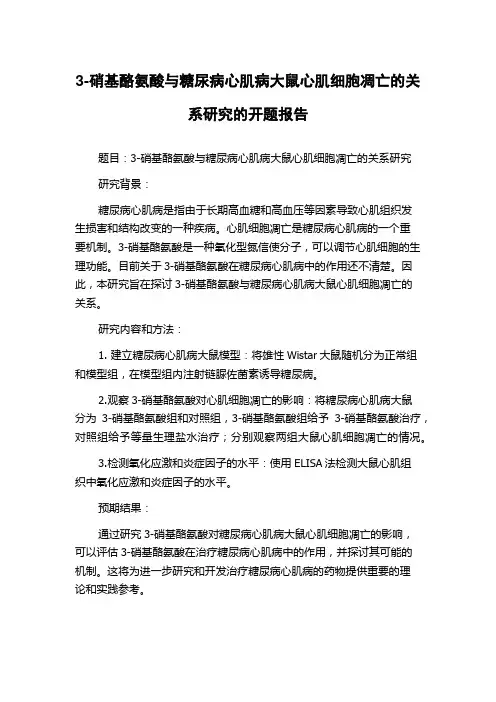
3-硝基酪氨酸与糖尿病心肌病大鼠心肌细胞凋亡的关
系研究的开题报告
题目:3-硝基酪氨酸与糖尿病心肌病大鼠心肌细胞凋亡的关系研究
研究背景:
糖尿病心肌病是指由于长期高血糖和高血压等因素导致心肌组织发
生损害和结构改变的一种疾病。
心肌细胞凋亡是糖尿病心肌病的一个重
要机制。
3-硝基酪氨酸是一种氧化型氮信使分子,可以调节心肌细胞的生理功能。
目前关于3-硝基酪氨酸在糖尿病心肌病中的作用还不清楚。
因此,本研究旨在探讨3-硝基酪氨酸与糖尿病心肌病大鼠心肌细胞凋亡的
关系。
研究内容和方法:
1. 建立糖尿病心肌病大鼠模型:将雄性Wistar大鼠随机分为正常组和模型组,在模型组内注射链脲佐菌素诱导糖尿病。
2.观察3-硝基酪氨酸对心肌细胞凋亡的影响:将糖尿病心肌病大鼠
分为3-硝基酪氨酸组和对照组,3-硝基酪氨酸组给予3-硝基酪氨酸治疗,对照组给予等量生理盐水治疗;分别观察两组大鼠心肌细胞凋亡的情况。
3.检测氧化应激和炎症因子的水平:使用ELISA法检测大鼠心肌组
织中氧化应激和炎症因子的水平。
预期结果:
通过研究3-硝基酪氨酸对糖尿病心肌病大鼠心肌细胞凋亡的影响,
可以评估3-硝基酪氨酸在治疗糖尿病心肌病中的作用,并探讨其可能的
机制。
这将为进一步研究和开发治疗糖尿病心肌病的药物提供重要的理
论和实践参考。
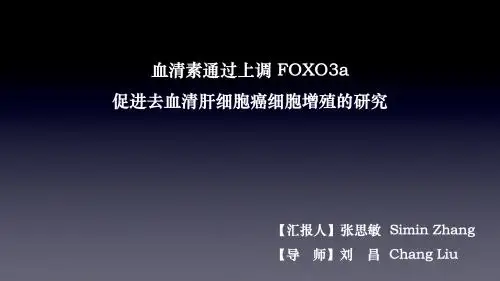
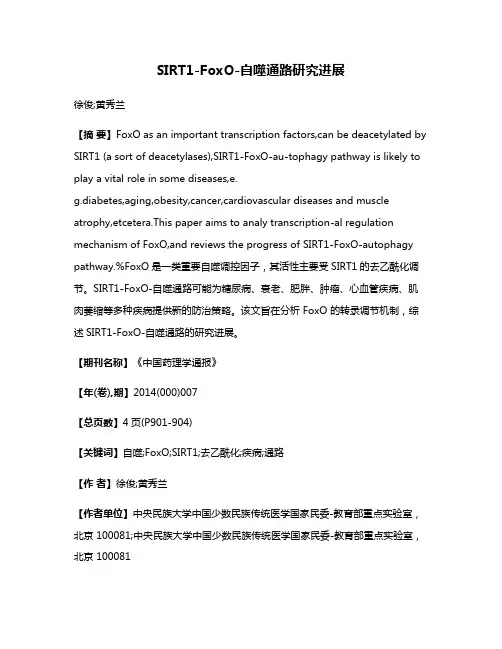
SIRT1-FoxO-自噬通路研究进展徐俊;黄秀兰【摘要】FoxO as an important transcription factors,can be deacetylated by SIRT1 (a sort of deacetylases),SIRT1-FoxO-au-tophagy pathway is likely to play a vital role in some diseases,e.g.diabetes,aging,obesity,cancer,cardiovascular diseases and muscle atrophy,etcetera.This paper aims to analy transcription-al regulation mechanism of FoxO,and reviews the progress of SIRT1-FoxO-autophagy pathway.%FoxO是一类重要自噬调控因子,其活性主要受SIRT1的去乙酰化调节。
SIRT1-FoxO-自噬通路可能为糖尿病、衰老、肥胖、肿瘤、心血管疾病、肌肉萎缩等多种疾病提供新的防治策略。
该文旨在分析 FoxO 的转录调节机制,综述SIRT1-FoxO-自噬通路的研究进展。
【期刊名称】《中国药理学通报》【年(卷),期】2014(000)007【总页数】4页(P901-904)【关键词】自噬;FoxO;SIRT1;去乙酰化;疾病;通路【作者】徐俊;黄秀兰【作者单位】中央民族大学中国少数民族传统医学国家民委-教育部重点实验室,北京 100081;中央民族大学中国少数民族传统医学国家民委-教育部重点实验室,北京 100081【正文语种】中文【中图分类】R-05;R329.24;R339.38;R394.2;R587.1;R589.2;R73;R54自噬是真核细胞内的蛋白质大分子、细胞器等在自噬溶酶体的作用下被降解的过程。
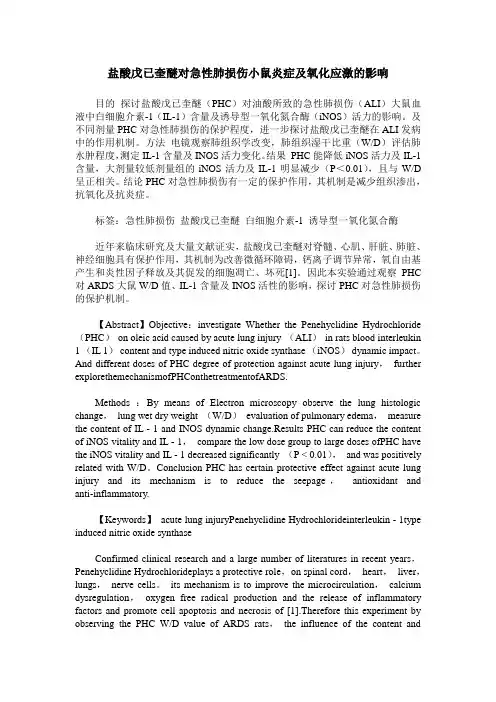
盐酸戊已奎醚对急性肺损伤小鼠炎症及氧化应激的影响目的探讨盐酸戊已奎醚(PHC)对油酸所致的急性肺损伤(ALI)大鼠血液中白细胞介素-1(IL-1)含量及诱导型一氧化氮合酶(iNOS)活力的影响。
及不同剂量PHC对急性肺损伤的保护程度,进一步探讨盐酸戊已奎醚在ALI发病中的作用机制。
方法电镜观察肺组织学改变,肺组织湿干比重(W/D)评估肺水肿程度,测定IL-1含量及INOS活力变化。
结果PHC能降低iNOS活力及IL-1含量,大剂量较低剂量组的iNOS活力及IL-1明显减少(P<0.01),且与W/D 呈正相关。
结论PHC对急性肺损伤有一定的保护作用,其机制是减少组织渗出,抗氧化及抗炎症。
标签:急性肺损伤盐酸戊已奎醚白细胞介素-1 诱导型一氧化氮合酶近年来临床研究及大量文献证实,盐酸戊已奎醚对脊髓、心肌、肝脏、肺脏、神经细胞具有保护作用,其机制为改善微循环障碍,钙离子调节异常,氧自由基产生和炎性因子释放及其促发的细胞凋亡、坏死[1]。
因此本实验通过观察PHC 对ARDS大鼠W/D值、IL-1含量及INOS活性的影响,探讨PHC对急性肺损伤的保护机制。
【Abstract】Objective:investigate Whether the Penehyclidine Hydrochloride (PHC)on oleic acid caused by acute lung injury (ALI)in rats blood interleukin 1 (IL 1)content and type induced nitric oxide synthase (iNOS)dynamic impact。
And different doses of PHC degree of protection against acute lung injury,further explorethemechanismofPHConthetreatmentofARDS.Methods :By means of Electron microscopy observe the lung histologic change,lung wet dry weight (W/D)evaluation of pulmonary edema,measure the content of IL - 1 and INOS dynamic change.Results PHC can reduce the content of iNOS vitality and IL - 1,compare the low dose group to large doses ofPHC have the iNOS vitality and IL - 1 decreased significantly (P < 0.01),and was positively related with W/D。
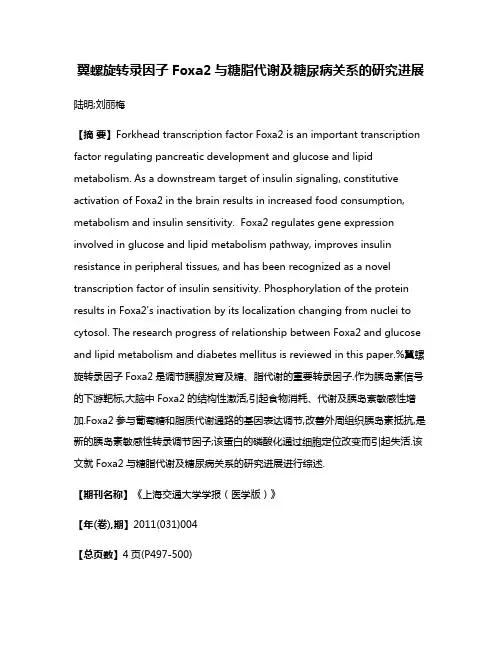
翼螺旋转录因子Foxa2与糖脂代谢及糖尿病关系的研究进展陆明;刘丽梅【摘要】Forkhead transcription factor Foxa2 is an important transcription factor regulating pancreatic development and glucose and lipid metabolism. As a downstream target of insulin signaling, constitutive activation of Foxa2 in the brain results in increased food consumption, metabolism and insulin sensitivity. Foxa2 regulates gene expression involved in glucose and lipid metabolism pathway, improves insulin resistance in peripheral tissues, and has been recognized as a novel transcription factor of insulin sensitivity. Phosphorylation of the protein results in Foxa2's inactivation by its localization changing from nuclei to cytosol. The research progress of relationship between Foxa2 and glucose and lipid metabolism and diabetes mellitus is reviewed in this paper.%翼螺旋转录因子Foxa2是调节胰腺发育及糖、脂代谢的重要转录因子.作为胰岛素信号的下游靶标,大脑中Foxa2的结构性激活,引起食物消耗、代谢及胰岛紊敏感性增加.Foxa2参与葡萄糖和脂质代谢通路的基因表达调节,改善外周组织胰岛素抵抗,是新的胰岛素敏感性转录调节因子;该蛋白的磷酸化通过细胞定位改变而引起失活.该文就Foxa2与糖脂代谢及糖尿病关系的研究进展进行综述.【期刊名称】《上海交通大学学报(医学版)》【年(卷),期】2011(031)004【总页数】4页(P497-500)【关键词】Foxa2;糖脂代谢;糖尿病【作者】陆明;刘丽梅【作者单位】上海交通大学附属第六人民医院内分泌代谢科,上海市糖尿病研究所,上海,200233;上海交通大学附属第六人民医院内分泌代谢科,上海市糖尿病研究所,上海,200233【正文语种】中文【中图分类】R587.1翼螺旋转录因子叉头框(forkhead box,Fox),主要在肝脏、胰腺、肺和脂肪组织中表达,是调节胰腺发育及糖脂代谢的重要转录因子。
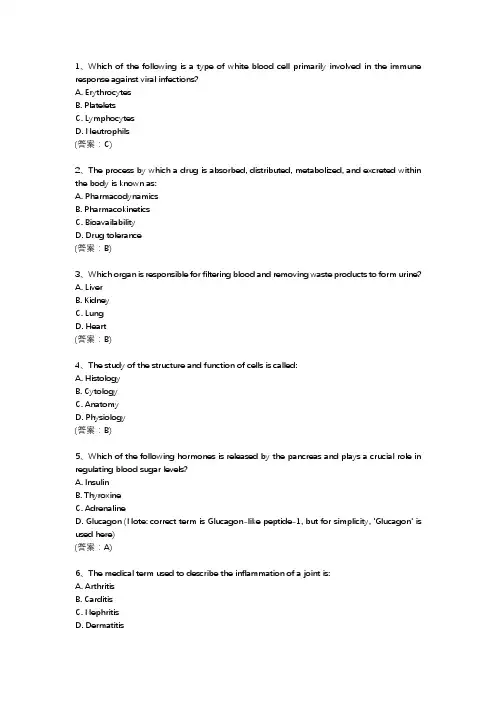
1、Which of the following is a type of white blood cell primarily involved in the immune response against viral infections?A. ErythrocytesB. PlateletsC. LymphocytesD. Neutrophils(答案:C)2、The process by which a drug is absorbed, distributed, metabolized, and excreted within the body is known as:A. PharmacodynamicsB. PharmacokineticsC. BioavailabilityD. Drug tolerance(答案:B)3、Which organ is responsible for filtering blood and removing waste products to form urine?A. LiverB. KidneyC. LungD. Heart(答案:B)4、The study of the structure and function of cells is called:A. HistologyB. CytologyC. AnatomyD. Physiology(答案:B)5、Which of the following hormones is released by the pancreas and plays a crucial role in regulating blood sugar levels?A. InsulinB. ThyroxineC. AdrenalineD. Glucagon (Note: correct term is Glucagon-like peptide-1, but for simplicity, 'Glucagon' is used here)(答案:A)6、The medical term used to describe the inflammation of a joint is:A. ArthritisB. CarditisC. NephritisD. Dermatitis(答案:A)7、Which of the following imaging techniques uses high-frequency sound waves to produce images of internal body structures?A. X-rayB. CT scanC. UltrasoundD. MRI(答案:C)8、The process of converting food into energy that the body can use is known as:A. DigestionB. MetabolismC. AbsorptionD. Assimilation(答案:B)9、Which vitamin is essential for maintaining healthy bones and teeth, and is primarily obtained from sunlight exposure?A. Vitamin AB. Vitamin CC. Vitamin DD. Vitamin K(答案:C)10、The branch of medicine that deals with the prevention, diagnosis, and treatment of diseases of the heart and blood vessels is called:A. NeurologyB. CardiologyC. DermatologyD. Gastroenterology(答案:B)。
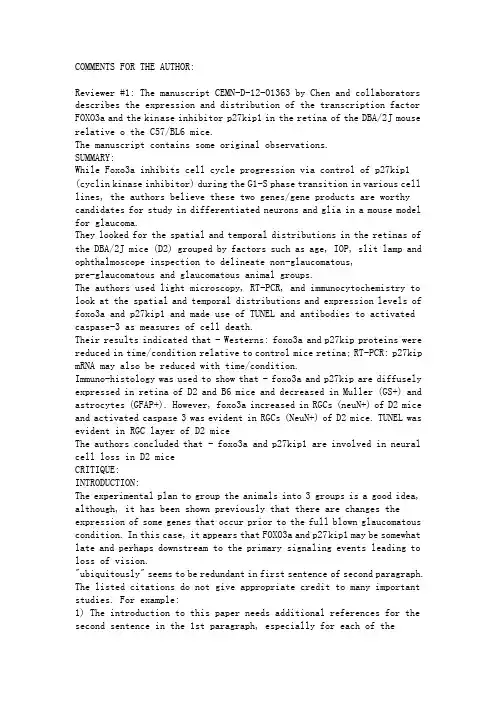
COMMENTS FOR THE AUTHOR:Reviewer #1: The manuscript CEMN-D-12-01363 by Chen and collaborators describes the expression and distribution of the transcription factor FOXO3a and the kinase inhibitor p27kip1 in the retina of the DBA/2J mouse relative o the C57/BL6 mice.The manuscript contains some original observations.SUMMARY:While Foxo3a inhibits cell cycle progression via control of p27kip1 (cyclin kinase inhibitor) during the G1-S phase transition in various cell lines, the authors believe these two genes/gene products are worthy candidates for study in differentiated neurons and glia in a mouse model for glaucoma.They looked for the spatial and temporal distributions in the retinas of the DBA/2J mice (D2) grouped by factors such as age, IOP, slit lamp and ophthalmoscope inspection to delineate non-glaucomatous,pre-glaucomatous and glaucomatous animal groups.The authors used light microscopy, RT-PCR, and immunocytochemistry to look at the spatial and temporal distributions and expression levels of foxo3a and p27kip1 and made use of TUNEL and antibodies to activated caspase-3 as measures of cell death.Their results indicated that - Westerns: foxo3a and p27kip proteins were reduced in time/condition relative to control mice retina; RT-PCR: p27kip mRNA may also be reduced with time/condition.Immuno-histology was used to show that - foxo3a and p27kip are diffusely expressed in retina of D2 and B6 mice and decreased in Muller (GS+) and astrocytes (GFAP+). However, foxo3a increased in RGCs (neuN+) of D2 mice and activated caspase 3 was evident in RGCs (NeuN+) of D2 mice. TUNEL was evident in RGC layer of D2 miceThe authors concluded that - foxo3a and p27kip1 are involved in neural cell loss in D2 miceCRITIQUE:INTRODUCTION:The experimental plan to group the animals into 3 groups is a good idea, although, it has been shown previously that there are changes the expression of some genes that occur prior to the full blown glaucomatous condition. In this case, it appears that FOXO3a and p27kip1 may be somewhat late and perhaps downstream to the primary signaling events leading to loss of vision."ubiquitously" seems to be redundant in first sentence of second paragraph. The listed citations do not give appropriate credit to many important studies. For example:1) The introduction to this paper needs additional references for the second sentence in the 1st paragraph, especially for each of themechanisms suggested as primary causes of RGC cell death. The author should add excitotoxicity as one of the postulated mechanisms here - especially as foxo3a has been implicated in apoptosis.2) Paragraph 4 of the introduction - the authors may want to cite the 2001 Nobel laureates for their discoveries of the role of cyclins and CDKs in cell cycle progression.3) The authors must cite Ophthalmol Eye Dis. 2010 March 11; 1: 23-41, a microarray study where up-regulation of GFAP (Muller cells and astrocytes) and Iba1 (microglia) were shown and where a CDI was also shown to be increased in the DBA/2J mouse retina. At the very least this should be in the last paragraph of the introduction, and probably, also used in the discussion.4) The authors should also cite Invest Ophthalmol Vis Sci 2006;47:977-85 another important gene expression study. This should also go, at least in the last paragraph of the introduction.METHODS:Can the authors state how they determined an illumination level of 50-60 lux for housing the animals? Just curious.I would like to see a table for the 3 DBA/2J animal groups with the various factors used to assign animals to this or that group. This might be helpful to investigators who use these animals.Catalogue numbers should be used to identify the antibodies that were used. RESULTS:In second and fifth lines of the first paragraph, what is meant by the term "control group" here? Are these B6 or are they D2- non glaucomatous mice? You also use the term "control" for no-primary controls, for example, in the figure legends. So always be specific.The last sentence of the first paragraph states that neurodegeneration induced a decrease in foxo3a and p27kip1. The term "induced" may be inappropriate here.The second paragraph speaks of a decrease in immuno-staining. This is difficult to discern, perhaps due to the use of cresyl violet as a counterstain. It might be better to not use a nuclear counterstain. I cannot see the translocation from nucleus to cytoplasm. Again this might have been possible without the dark blue counterstain.I cannot see much overlap between foxo or p27 with the Muller cell glutamine synthase in figure3. While the author has boxed a possible example, there are many instances where the labeling is either red or green. There are hints of foxo and p27 in the middle layer of the INL and in the OPL, but the figure could be improved.There is some evidence in Figure 4 for double labeled cells containing both markers for GFAP and Foxo but all-GFAP or all-Foxo labeled cells are also to be seen. Can the authors explain this?The statement indicating a cause and effect relationship between FOXO andp27 may be misplaced, at least in this part of the results section. There does appear to be a correlation between the relative abundance of FOXO and p27 in the retina as judged from western blots of the whole retina, but you have also made a case for increased abundance of FOXO in RGCs. Thus, it is not clear that your argument is consistent at the cellular level, or at least, it is not made clear to this reviewer.It is not clear that figure 8 adds anything that has not already been reported and the data are not that convincing anyway. It might have been useful to show the presence of cleaved caspase or TUNEL in double labeled cells containing FOXO or p27 because the direct connection between FOXo and p27 with cell death is somewhat tenuous in this manuscript. DISCUSSION:Much is lost in translation and this is particularly true of the discussion section where misleading statements such as "The present data reveal that down-regulation of p27kip1 through FOXO transcriptional inhibition was associated with ----" and "our results demonstrated that Foxo3a as a positive regulator of p27kip1 was associated with ---" can be found. There is little integration with the existing data on the DBA/2J mouse or any other animal model of glaucoma.Reviewer #2: In this study the authors show that the transcription factor FOXO3a and its downstream gene p27kip1 are decreased in glaucomatous DBA/2J retinas. The decreased expression of these proteins was found in the Müller cells and astrocytes. The authors also found increased expression of FOXO3a in RGCs from glaucomatous retinas. The latter finding seems to be correlated with the apoptosis of RGCs, observed with TUNEL and Caspase3 staining in glaucomatous retinas.Major points:1) The authors were able to show that FOXO3a and p27kip1 expression levels are changing in glaucomatous retinas, however the study lacks a direct connection between their findings and the cellular processes in which these proteins are involved. Downregulation of FOXO3a and p27kip1 have been proposed to be involved in cell proliferation, while upregulation of FOXO3a in neurons is associated with apoptosis. It will be interesting if the authors are able to establish the connection between the expression of these proteins and the cellular events mentioned above. A previous study has shown the involvement of the PTEN-Akt-FOXO3a pathway in neuronal apoptosis in brain development after hypoxia-ischemia (Li et al., J Cereb Blood Flow Metab, 2009). In this study, the expression of Bim, an apoptosis related protein that is downstream of FOXO3a, is increased as a response of FOXO3a nuclear translocation. The authors could demonstrate the link between FOXO3a and apoptosis byshowing dephosphorylation in the PTEN-Akt-FOXO3a pathway and the consequent increased levels of Bim in glaucomatous RGCs. In this way the authors might propose a possible mechanism of apoptosis that could betargeted therapeutically in glaucoma.2) It is necessary to include an optic nerve assessment of degeneration for the establishment of glaucoma in these mice. The use of an axonal antibody in the optic nerve could be a good alternative.。
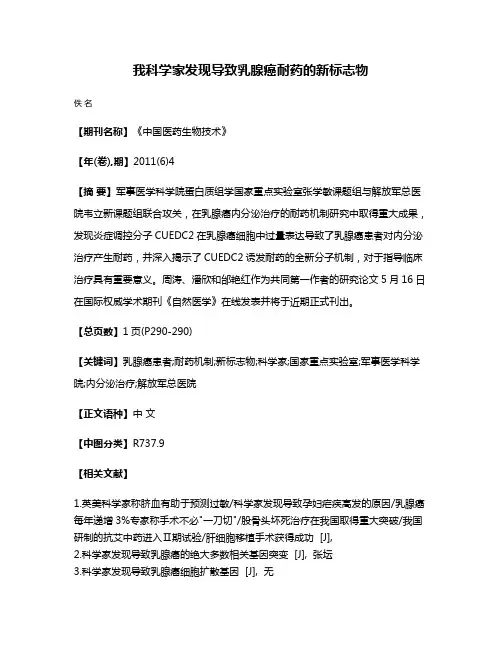
我科学家发现导致乳腺癌耐药的新标志物
佚名
【期刊名称】《中国医药生物技术》
【年(卷),期】2011(6)4
【摘要】军事医学科学院蛋白质组学国家重点实验室张学敏课题组与解放军总医院韦立新课题组联合攻关,在乳腺癌内分泌治疗的耐药机制研究中取得重大成果,发现炎症调控分子CUEDC2在乳腺癌细胞中过量表达导致了乳腺癌患者对内分泌治疗产生耐药,并深入揭示了CUEDC2诱发耐药的全新分子机制,对于指导临床治疗具有重要意义。
周涛、潘欣和邰艳红作为共同第一作者的研究论文5月16日在国际权威学术期刊《自然医学》在线发表并将于近期正式刊出。
【总页数】1页(P290-290)
【关键词】乳腺癌患者;耐药机制;新标志物;科学家;国家重点实验室;军事医学科学院;内分泌治疗;解放军总医院
【正文语种】中文
【中图分类】R737.9
【相关文献】
1.英美科学家称脐血有助于预测过敏/科学家发现导致孕妇疟疾高发的原因/乳腺癌每年递增3%专家称手术不必"一刀切"/股骨头坏死治疗在我国取得重大突破/我国研制的抗艾中药进入Ⅱ期试验/肝细胞移植手术获得成功 [J],
2.科学家发现导致乳腺癌的绝大多数相关基因突变 [J], 张坛
3.科学家发现导致乳腺癌细胞扩散基因 [J], 无
4.科学家发现导致乳腺癌扩散基因 [J],
5.耐药机制是乳腺癌治疗一个亟待解决的难题我科学家发现导致乳腺癌耐药的新标志物 [J],
因版权原因,仅展示原文概要,查看原文内容请购买。
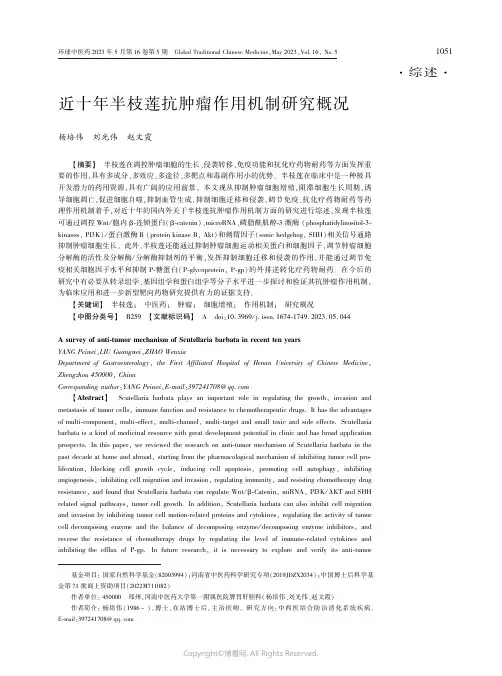
环球中医药2023年5月第16卷第5期 Global Traditional Chinese Medicine,May 2023,Vol.16,No.51051 ㊃综述㊃基金项目:国家自然科学基金(82003994);河南省中医药科学研究专项(2019JDZX2034);中国博士后科学基金第71批面上资助项目(2022M711082)作者单位:450000 郑州,河南中医药大学第一附属医院脾胃肝胆科(杨培伟㊁刘光伟㊁赵文霞)作者简介:杨培伟(1986-),博士,在站博士后,主治医师㊂研究方向:中西医结合防治消化系统疾病㊂E⁃mail:397241708@近十年半枝莲抗肿瘤作用机制研究概况杨培伟 刘光伟 赵文霞【摘要】 半枝莲在调控肿瘤细胞的生长㊁侵袭转移㊁免疫功能和抗化疗药物耐药等方面发挥重要的作用,具有多成分㊁多效应㊁多途径㊁多靶点和毒副作用小的优势㊂半枝莲在临床中是一种极具开发潜力的药用资源,具有广阔的应用前景㊂本文现从抑制肿瘤细胞增殖,阻滞细胞生长周期,诱导细胞凋亡,促进细胞自噬,抑制血管生成,抑制细胞迁移和侵袭,调节免疫㊁抗化疗药物耐药等药理作用机制着手,对近十年的国内外关于半枝莲抗肿瘤作用机制方面的研究进行综述,发现半枝莲可通过调控Wnt /胞内β⁃连锁蛋白(β⁃catenin)㊁microRNA㊁磷脂酰肌醇⁃3激酶(phosphatidylinositol⁃3⁃kinases,PI3K)/蛋白激酶B (protein kinase B,Akt)和刺猬因子(sonic hedgehog,SHH)相关信号通路抑制肿瘤细胞生长㊂此外,半枝莲还能通过抑制肿瘤细胞运动相关蛋白和细胞因子,调节肿瘤细胞分解酶的活性及分解酶/分解酶抑制剂的平衡,发挥抑制细胞迁移和侵袭的作用,并能通过调节免疫相关细胞因子水平和抑制P⁃糖蛋白(P⁃glycoprotein,P⁃gp)的外排逆转化疗药物耐药㊂在今后的研究中有必要从转录组学㊁基因组学和蛋白组学等分子水平进一步探讨和验证其抗肿瘤作用机制,为临床应用和进一步新型靶向药物研究提供有力的证据支持㊂【关键词】 半枝莲; 中医药; 肿瘤; 细胞增殖; 作用机制; 研究概况【中图分类号】 R259 【文献标识码】 A doi:10.3969/j.issn.1674⁃1749.2023.05.044A survey of anti⁃tumor mechanism of Scutellaria barbata in recent ten years YANG Peiwei ,LIU Guangwei ,ZHAO WenxiaDepartment of Gastroenterology ,the First Affiliated Hospital of Henan University of Chinese Medicine ,Zhengzhou 450000,ChinaCorresponding author :YANG Peiwei ,E⁃mail :397241708@【Abstract 】 Scutellaria barbata plays an important role in regulating the growth,invasion and metastasis of tumor cells,immune function and resistance to chemotherapeutic drugs.It has the advantagesof multi⁃component,multi⁃effect,multi⁃channel,multi⁃target and small toxic and side effects.Scutellaria barbata is a kind of medicinal resource with great development potential in clinic and has broad applicationprospects.In this paper,we reviewed the research on anti⁃tumor mechanism of Scutellaria barbata in thepast decade at home and abroad,starting from the pharmacological mechanism of inhibiting tumor cell pro⁃liferation,blocking cell growth cycle,inducing cell apoptosis,promoting cell autophagy,inhibitingangiogenesis,inhibiting cell migration and invasion,regulating immunity,and resisting chemotherapy drug resistance,and found that Scutellaria barbata can regulate Wnt /β⁃Catenin,miRNA,PI3K /AKT and SHHrelated signal pathways,tumor cell growth.In addition,Scutellaria barbata can also inhibit cell migrationand invasion by inhibiting tumor cell motion⁃related proteins and cytokines,regulating the activity of tumorcell decomposing enzyme and the balance of decomposing enzyme /decomposing enzyme inhibitors,and reverse the resistance of chemotherapy drugs by regulating the level of immune⁃related cytokines andinhibiting the efflux of P⁃gp.In future research,it is necessary to explore and verify its anti⁃tumor1052 环球中医药2023年5月第16卷第5期 Global Traditional Chinese Medicine,May2023,Vol.16,No.5 mechanism at the molecular level of transcriptomics,genomics and proteomics,so as to provide strongevidence for clinical application and further research and development of new targeted drugs.【Key words】 Scutellaria barbata D.Don; Traditional Chinese medicine; Tumor; Cell proliferation; Mechanism of action; Research overview 现代研究认为炎症参与了肿瘤的发生发展㊁侵袭和转移等病理过程[1]㊂而中医认为,炎症与热毒的作用类似,是肿瘤的病理因素和病理产物,是肿瘤发生发展的重要原因之一[2]㊂因此,清热解毒法是中医药治疗肿瘤的常用法则之一㊂半枝莲是唇形科植物,味辛㊁苦㊁寒,归肺㊁肝㊁肾经,具有清热解毒㊁化瘀利尿的作用,用于各种炎症㊁咽喉痛㊁水肿㊁黄疸等[3⁃4]㊂有研究证实半枝莲可以控制和消除肿瘤及其周围的炎性水肿,在一定程度上减轻或抑制肿瘤的进展[5]㊂近年来,半枝莲被用于治疗各种癌症,如肺癌㊁肝癌㊁乳腺癌㊁卵巢癌和大肠癌等的治疗[4]㊂半枝莲在调控肿瘤细胞的生长㊁侵袭转移㊁免疫功能和抗化疗药物耐药等方面发挥重要的作用,具有多途径和多靶点的优势㊂本文针对近十年来半枝莲抗肿瘤作用机制进行归纳和总结,旨在探索和阐明半枝莲抗肿瘤的具体作用机制,以期为半枝莲的临床应用及其在抗肿瘤方面的进一步研究与开发提供理论依据㊂1 抑制肿瘤细胞的生长1.1 抑制肿瘤细胞的增殖肿瘤细胞是不受正常生长调控系统控制的持续分裂和异常增殖的细胞㊂研究发现通过生物活性定向分离法分离出的半枝莲及其提取物中的化合物对多种肿瘤细胞株如肺癌A549㊁人早幼粒白血病细胞HL⁃60等具有细胞毒性活性[5],可根据毒性活性的强弱判断其化合物对该肿瘤细胞系的抗增殖活性[6]㊂Wei等[7]研究显示半枝莲乙醇提取物(ethanol extract of Scutellaria barbata,EESB)通过抑制Wnt/β⁃catenin通路的激活,如降低别藻蓝蛋白(allophycocyanin,APC)和β⁃catenin的蛋白表达,显著降低结直肠癌(cancer of the rectum,CRC)异种移植小鼠的肿瘤生长,并抑制了CRC细胞HT⁃29细胞的活力㊂刘明胜等[8]研究也提示,EESB可通过调控circ0092283/miR⁃198轴,降低结直肠癌HCT⁃116细胞的克隆形成能力,抑制CRC细胞的增殖㊂许多miRNA在癌症的调节中发挥着至关重要的作用,半枝莲与白花蛇舌草配伍可以通过减少miR⁃155表达降低Akt活化,抑制膀胱癌细胞生长和克隆形成[9]㊂综上所述,半枝莲及其提取物可能通过调控多种基因和信号通路的表达,抑制肿瘤细胞增殖发挥抗肿瘤作用,提示半枝莲抗肿瘤作用可能与抑制肿瘤细胞增殖有关,其对于抗肿瘤的防治具有重要价值㊂抑制该细胞进程可为研发抗肿瘤药物寻找新靶点,并且为临床中进一步使用半枝莲作为抗肿瘤药物提供了实验依据㊂1.2 阻滞肿瘤细胞生长周期细胞有丝分裂是细胞增殖的主要方式,与调节性细胞周期蛋白形成复合物对细胞进入有丝分裂起着重要作用㊂Chen等[10]研究表明,半枝莲通过P38/SIRT1介导细胞周期G2/M期阻滞和内质网应激㊁内源性线粒体和外源性FAS/FASL介导的通路,在体内外水平上抑制CL1⁃5肺癌细胞的生长㊂芦冲等[11]研究显示,半枝莲醇提物含药血清通过阻滞G0/G1期人结肠癌HT⁃29细胞周期分布,抑制HT⁃29细胞增殖,发挥抗肿瘤作用㊂Hnit等[12]研究报道,半枝莲配伍白花蛇舌草可能通过降低前列腺癌细胞周期相关蛋白Cyclin B1㊁周期蛋白依赖性激酶(cyclin⁃dependent kinases,CDK1)㊁丝氨酸/苏氨酸激酶(Polo⁃like Kinase1,PLK1)和Aurora A蛋白和mRNA水平的表达,抑制前列腺癌细胞细胞周期G2向M的转化,进而发挥抗肿瘤作用㊂据此可知,半枝莲可通过阻滞肿瘤细胞周期进程,降低肿瘤细胞周期相关蛋白的表达水平,抑制有丝分裂进入细胞,进而发挥抗肿瘤的作用㊂1.3 诱导肿瘤细胞凋亡细胞凋亡是一种程序性细胞死亡形式,与细胞形态的变化有关,是抗肿瘤的重要效应机制之一㊂Shim等[13]研究显示半枝莲提取物通过激活半胱天冬酶㊁增加线粒体膜去极化和Caspase⁃3/9的活性,调节丝裂原活化蛋白激酶(mitogen⁃activated protein kinase,MAPK)和活性氧(reactiveoxygenspecies, ROS)依赖性途径,触发人胃腺癌细胞系MKN⁃45细胞的凋亡,在体内外水平抑制人胃腺癌细胞的生长㊂半枝莲还可与白花蛇舌草作为药对配伍,通过表皮生长因子受体(epidermal growth factor receptor, EGFR)/过氧化物酶体增殖物激活受体(peroxisome环球中医药2023年5月第16卷第5期 Global Traditional Chinese Medicine,May2023,Vol.16,No.51053proliferators⁃activated receptorγ,PPARγ)/PI3K/ AKT通路诱导细胞凋亡,在体内外水平上抑制肿瘤细胞生长[14]㊂李秋平[15]的实验研究也提示半枝莲提取物可能通过影响内质网应激标志蛋白葡萄糖调节蛋白(glucose regulatory protein78/immunoglobulin binding protein,GRP78/Bip)㊁CCAAT/增强子结合蛋白同源蛋白(C/enhancer binding protein⁃homologous protein,CHOP)和半胱氨酸天冬氨酸蛋白酶⁃12 (Caspase⁃12)蛋白的表达,促进肺癌A549细胞凋亡,进而抑制肺癌细胞的生长㊂可见,半枝莲可以通过调控凋亡因子或凋亡相关蛋白的表达影响肿瘤细胞的生长㊂这也提示其抗肿瘤作用机制可能与促进肿瘤细胞凋亡有关,对于新型抗肿瘤药物研发具有重要意义,然而其具体作用机制仍需要大量的实验研究进行证实㊂1.4 促进肿瘤细胞自噬细胞自噬也称为Ⅱ型程序性细胞死亡,和细胞凋亡一样也是维持机体和细胞稳态的重要分子过程,细胞自噬和肿瘤细胞的发生发展有关㊂中药对肿瘤细胞自噬具有增强㊁抑制或双向调控作用,肿瘤细胞存在更强的保护性自噬以支撑肿瘤细胞的快速增殖和转移等,但过渡自噬又可导致肿瘤细胞死亡,出现死亡性自噬[16]㊂研究发现半枝莲可增加肺癌CL1⁃5细胞中自噬相关蛋白(light chain3II,LC3II)的表达,镜下可观察到大量的自噬泡和受损的线粒体,应用3⁃甲基腺嘌呤(3⁃Methyladenine,3⁃MA),一种自噬抑制剂后,半枝莲诱导的细胞死亡被抑制,表明半枝莲可通过诱导细胞自噬促进CL1⁃5细胞死亡[10]㊂陈明等[17]实验研究显示,半枝莲总黄酮(total flavonoids of scutellaria barbata,TF⁃SB)可能通过抑制PI3K/ AKT/哺乳动物雷帕霉素靶点(mammalian target of rapamycin,mTOR)通路,诱导黑色素肿瘤细胞自噬,通过增强其自噬活性来抑制黑色素瘤荷瘤小鼠肿瘤生长㊂罗宗保等[18]研究也表明半枝莲可通过诱导宫颈癌Hela细胞自噬活性,抑制PI3K/AKT/ mTOR信号通路蛋白磷酸化来发挥抗肿瘤作用㊂因此,半枝莲可能通过诱导肿瘤细胞自噬发挥抗肿瘤效应,这也体现出中药治疗疾病是多途径多靶点综合作用的结果,同时也说明了中药的复杂性㊁模糊性和不确定性㊂1.5 抑制肿瘤血管生成血管生成是一个复杂的过程,以血管再生为靶点的药物在抑制肿瘤血管生成方面是研究的热点之一,对研发肿瘤血管生成抑制剂具有重要的作用㊂半枝莲多糖通过下调磷酸化细胞间质上皮转换因子(cellular⁃mesenchymal epithelial transitionfactor,c⁃Met)及其下游磷酸化细胞外信号调节激酶(phosphorylated extracellular signal regulated kinase, p⁃Erk)和p⁃Akt的表达,抑制人表皮生长因子受体⁃2 (human epidermal growth factor receptor2,HER2)通路,对人肺腺癌细胞Calu⁃3皮下移植瘤模型发挥抗血管生成的作用[19]㊂Shiau等[20]研究报道,半枝莲通过下调低氧诱导因子⁃1α(hypoxia inducible factor⁃1,HIF⁃1α)依赖性血管内皮生长因子(vascular endothelial growth factor,VEGF)的表达,抑制肺癌细胞的血管生成,提示半枝莲具有抗血管生成的活性㊂信号传导的重要靶基因是血管生成的最强刺激剂之一,通过调控SHH通路抑制血管生成已成为肿瘤化疗的一个重要方向,Wei 等[21]实验研究发现,EESB通过抑制SHH通路及其下游靶基因血管内皮生长因子A(VEGF⁃A)的表达,进而抑制结直肠癌小鼠模型中的肿瘤血管生成㊂这些研究提示抑制肿瘤血管生成可能是半枝莲有效治疗癌症的作用机制之一,这也为从抗肿瘤血管生成的角度研发抗肿瘤药物提供了一定的依据,为半枝莲的开发利用拓展了更广阔的研究空间㊂2 抑制肿瘤细胞侵袭和转移肿瘤细胞的迁移和侵袭是一个多步骤㊁与宿主细胞相互作用的生物学过程,是肿瘤细胞最异常的行为之一,和肿瘤治疗的远期效果密切相关㊂一旦出现肿瘤细胞的侵袭和转移,其复发率和相关的死亡率风险更高,因此抑制侵袭和转移仍然是癌症治疗的一个重要挑战㊂2.1 调控肿瘤细胞运动相关蛋白和细胞因子肿瘤细胞的运动能力是肿瘤侵袭周围组织㊁发生远处转移的基本条件,细胞具有活跃的运动能力,其侵袭转移的潜能就越强㊂而运动相关蛋白和细胞因子在肿瘤细胞的运动过程中发挥着重要作用㊂迁移侵袭抑制蛋白(migration and invasion inhibitory protein,MIIP)基因在胃癌㊁乳腺癌㊁结肠癌㊁子宫内膜癌等恶性肿瘤中呈低表达,与肿瘤的发生发展有相关性[22⁃25]㊂1054 环球中医药2023年5月第16卷第5期 Global Traditional Chinese Medicine,May2023,Vol.16,No.5张锋等[26]最新研究发现半枝莲总黄酮通过上调MIIP表达可以抑制人胃腺癌细胞AGS细胞的增殖和诱导细胞凋亡,进而发挥抗胃癌作用㊂肿瘤细胞出现上皮间质转化(epithelial⁃mesenchymaltransition,EMT)时,标志着肿瘤细胞浸润转移的开始,而E⁃钙粘素和Twist蛋白等是EMT过程中的重要调控因子,促进肿瘤细胞侵袭和远处转移㊂陈志成等[27]研究也证实半枝莲提取物可能通过上调E⁃钙粘素和下调Twist蛋白的表达,抑制大肠癌LoVo 细胞的增殖和侵袭能力㊂上述研究表明,半枝莲作为清热解毒药,其通过影响肿瘤细胞的运动能力的作用已经得到人们的重视㊂半枝莲调控肿瘤细胞运动相关蛋白和细胞因子的作用,为肿瘤的治疗开辟了新途径㊂同时这些研究也为临床上应用半枝莲治疗肿瘤的分子机制提供了有力的理论证据支撑㊂2.2 调节肿瘤细胞分解酶的活性及分解酶/分解酶抑制剂的平衡基质金属蛋白酶家族(matrix metalloproteinases, MMPs)已被证实在肿瘤细胞侵袭和转移中具有重要作用,高侵袭和高转移性的肿瘤细胞分泌有高含量的MMPs㊂研究发现中医药可以通过调节分解酶的活性以及平衡分解酶/分解酶抑制剂来抑制细胞外基质的降解,进而抑制肿瘤细胞的侵袭和转移㊂最近的研究显示,半枝莲通过降低基质金属蛋白酶MMP⁃1/2㊁MMP⁃3/10和MMP⁃9/13的表达,以及PI3K/AKT和转化生长因子β(transforming growth factor⁃β,TGF⁃β)/Smad信号通路中的蛋白,抑制结直肠癌HCT⁃8的迁移和侵袭[28]㊂半枝莲还可通过降低MMP⁃2/9表达的线粒体途径,抑制卵巢癌A2780细胞迁移㊁增殖和诱导凋亡,进而发挥抗卵巢癌的作用[29]㊂黄有星等[30]研究证实半枝莲提取物通过阻断TGF⁃β/Smad/AMPK信号通路,下调整合素αV㊁整合素β3㊁MMP⁃2/9,逆转TGF⁃β诱导的EMT,抑制肝癌HepG2细胞迁移和侵袭㊂据此可知,从中药中寻找和研发抑制MMPs的新颖制剂是抗肿瘤药物发现的重要途径,对于半枝莲的进一步开发和应用具有更好的前景㊂3 调节机体免疫功能免疫系统在抗肿瘤防御中起着重要作用,免疫疗法是肿瘤患者的潜在治疗选择㊂Son等[31]研究发现,半枝莲的主要活性成分糖蛋白对淋巴细胞增殖㊁抗体产生和细胞因子分泌具有诱导免疫刺激的作用㊂Gong等[32]研究提示,半枝莲可以通过降低体内IL⁃6/10/17㊁叉头蛋白P3 (forkhead box protein3,FOXP3)㊁TGF⁃β1和维甲酸相关孤核受体γt(retinoid⁃related orphan receptorγt, RORγt)水平,增加IL⁃2和干扰素γ(interferon⁃γ, IFN⁃γ)的表达,抑制Lewis荷瘤C57BL/6小鼠肿瘤生长和调节免疫功能㊂肿瘤细胞可以募集调节细胞Treg来抑制肿瘤微环境中的抗肿瘤免疫,从而限制了癌症免疫治疗的效率㊂EESB通过下调肿瘤组织中免疫相关的CD4+CD25+Foxp3+Treg细胞和Th17细胞数量以及IL⁃10/17A和TGF⁃β的水平,提高脾脏NK细胞的细胞毒性及血清IL⁃2和IFN⁃γ水平,抑制HepG2细胞的增殖和H22荷瘤小鼠的肿瘤生长[33]㊂肿瘤的发生发展作用机制复杂,免疫因素在肿瘤的发生发展预后等方面发挥重要作用,而如何调控免疫因素是抑制或促进仍然是治疗肿瘤的关键㊂半枝莲及其提取物调控肿瘤免疫的作用可能将成为研究肿瘤治疗的新方向之一㊂4 抗化疗药物耐药性化疗药物是肿瘤治疗的一项重要选择,然而肿瘤细胞会在一定程度上对化疗药物产生耐药性,这是抗肿瘤治疗失败的重要因素之一㊂研究表明为代表的ABC转运蛋白超家族异常表达引起的药物外排是产生多药耐药(multidrug re⁃sistance,MDR)的主要机制之一,从半枝莲中分离出的新克罗烷型二萜化合物可能是通过抑制P⁃gp 的外排功能来逆转HepG2/阿霉素(adriamycin, ADR)细胞对阿霉素的耐药性[34]㊂5⁃氟尿嘧啶(5⁃fluorouracil,5⁃FU)耐药或MDR已成为包括CRC在内的癌症临床治疗的主要障碍㊂EESB通过下调CyclinD1㊁Bcl⁃2和ATP结合盒亚家族G成员2(ATP binding cassette subfamily G member2,ABCG2)的表达,上调CRC细胞HCT⁃8/5⁃FU细胞p21和Bax的表达,抑制PI3K/AKT通路的激活,从而抑制结直肠癌HCT⁃8/5⁃FU细胞的化疗耐药[35]㊂综上所述,半枝莲及其提取物对多药耐药蛋白的抑制作用有利于抗肿瘤药物发挥其药效㊂这将为研究半枝莲及其提取物防止肿瘤的复发和多药耐药性发生奠定实验基础㊂环球中医药2023年5月第16卷第5期 Global Traditional Chinese Medicine,May2023,Vol.16,No.510555 半枝莲抗肿瘤其他机制研究5.1 影响肿瘤细胞中信号通路的表达有学者研究显示,半枝莲通过上调PI3K/AKT 依赖通路中Nrf2的表达,降低丙二醛(malondialdehyde,MDA)含量,提高超氧化物歧化酶(superoxide dismutase,SOD)和谷胱甘肽(glutathione,GSH)水平,减轻氧化损伤,恢复线粒体功能障碍,抑制氧糖剥夺/再灌注(oxygen and glucose deprivation/reperfusion,OGD/R)损伤的大鼠肾上腺嗜铬细胞瘤PC12细胞凋亡[36]㊂Zheng等[37]研究报道半枝莲总黄酮以剂量依赖性的方式,可以通过抑制肿瘤源性甲状旁腺激素相关蛋白(parathyroid hormone related protein,PtHrP)及其下游核因子⁃κB配体受体激活剂(receptor activator of NF⁃kB ligand,RANKL)/骨保护素(osteoprotegerin, OPG)的表达,抑制乳腺癌MDA⁃MB⁃231细胞迁移侵袭及骨转移㊂综上所述,PI3K/AKT通路㊁NF⁃κB通路可能参与半枝莲抗肿瘤作用机制,具体何种信号通路发挥主要作用与肿瘤细胞类型有关,具体研究何种信号通路也更有意义,因此仍需进一步挖掘和探索㊂5.2 抑制肿瘤细胞的癌症干性特征半枝莲可以通过抑制SHH信号通路抑制胰腺癌干细胞CSC的自我更新,从而延长胰腺癌患者的总生存期[38]㊂半枝莲提取物通过减弱SOX2/SMO/ GLI1轴,抑制非小细胞肺癌(Non⁃small cell lung cancer,NSCLC)细胞的癌症干性相关特征,抑制肿瘤细胞的生长[39]㊂ 综上所述,可从影响肿瘤干细胞生长的机制着手,探索半枝莲作为临床治疗中的新型抗癌药物,对进一步研发半枝莲药物提供了证据支持㊂6 思考与展望近年来,人们从动物实验和临床研究层面对半枝莲的抗肿瘤作用进行了研究㊂然而,在研究中仍存在一些不足㊂首先,应进一步挖掘半枝莲有效成分的抗肿瘤作用靶点,将传统药理活性与现代药理学相结合,了解其潜在的作用机制㊂其次,半枝莲抗肿瘤的分子机制,如转录组学㊁基因组学等方面的报道相对较少,这可能与中药成分复杂㊁药理活性成分检测困难有关,其抗肿瘤作用及机制有待进一步研究和探索㊂第三,半枝莲在临床上常与半边莲㊁白花蛇舌草等中药合用,应进一步研究半枝莲与药物的相互作用,以观察联合用药的效果㊂第四,对半枝莲中有发展前途的化合物或其他成分进行提取纯化,采用现代先进技术扩大其应用范围㊂因此,课题组认为半枝莲是一种极具开发潜力的药用资源,但其治疗效果和研究价值有待于今后的实验和临床研究进一步探讨和验证,以期为开发和利用半枝莲及其活性成分抗肿瘤提供理论和实验依据㊂参考文献[1] WU B,Sodji Q H,Oyelere A K.Inflammation,Fibrosis andCancer:Mechanisms,Therapeutic Options and Challenges[J].Cancers(Basel),2022,14(3):552.[2] 高宇,马云飞,陈宇晗,等.基于癌毒学说论治肿瘤经验[J].辽宁中医杂志,2021,48(12):42⁃45.[3] CHEN Q,Rahman K,WANG S J,et al.Scutellaria barbata:AReview on Chemical Constituents,Pharmacological Activities andClinical Applications[J].Curr Pharm Des,2020,26(1):160⁃175.[4] 国家药典委员会.中华人民共和国药典[M].北京:中国医学科学出版社,2020:118.[5] YUAN Q Q,SONG W B,WANG W Q,et al.Scubatines A⁃F,new cytotoxic neo⁃clerodane diterpenoids from Scutellaria barbataD.Don[J].Fitoterapia,2017,119:40⁃44.[6] MENG Q X,Roubin R H,Hanrahan J R.Ethnopharmacologicaland bioactivity guided investigation of five TCM anticancer herbs[J].J Ethnopharmacol,2013,148(1):229⁃238. [7] WEI L H,LIN J M,CHU J F,et al.Scutellaria barbata D.Doninhibits colorectal cancer growth via suppression of Wnt/beta⁃catenin signaling pathway[J].Chin J Integr Med,2017,23(11):858⁃863.[8] 刘明胜,陈文超,蔡颖畅.半枝莲醇提取物调控circ_0092283/miR⁃198对结直肠癌细胞克隆形成和凋亡的影响[J].中国药师,2021,24(9):1606⁃1611.[9] PAN L T,SHENG Y,GUO W P,et al.Hedyotis diffusa plusScutellaria barbata Induce Bladder Cancer Cell Apoptosis byInhibiting Akt Signaling Pathway through Downregulating miR⁃155Expression[J].Evid Based Complement Alternat Med,2016,2016:9174903.[10] CHEN C C,KAO C P,CHIU M M,et al.The anti⁃cancereffects and mechanisms of Scutellaria barbata D.Don on CL1⁃5lung cancer cells[J].Oncotarget,2017,8(65):109340⁃109357.[11] 芦冲,张睿苏,高彦宇,等.半枝莲醇提物含药血清对人结肠癌HT⁃29细胞增殖㊁凋亡和周期的影响[J].中医药学报,2016,44(2):51⁃54.[12] Hnit S S T,YAO M,XIE C,et al.Transcriptional regulation ofG2/M regulatory proteins and perturbation of G2/M Cell cycletransition by a traditional Chinese medicine recipe[J].J Ethno⁃pharmacol,2020,251:112526.1056 环球中医药2023年5月第16卷第5期 Global Traditional Chinese Medicine,May2023,Vol.16,No.5[13] Shim J H,Gim H,Lee S,et al.Inductions of Caspase⁃,MAPK⁃and ROS⁃dependent Apoptosis and Chemotherapeutic EffectsCaused by an Ethanol Extract of Scutellaria barbata D.Don inHuman Gastric Adenocarcinom Cells[J].J Pharmacopuncture,2016,19(2):129⁃136.[14] LU L,ZHAN S,LIU X,et al.Antitumor Effects and theCompatibility Mechanisms of Herb Pair Scleromitrion diffusum(Willd.)R.J.Wang⁃Sculellaria barbata D.Don[J].FrontPharmacol,2020,11:292.[15] 李秋平.半枝莲提取物对肺癌A549细胞增殖㊁凋亡的影响及与内质网应激的关系[D].衡阳:南华大学,2020. [16] 何曼,陈莉,曾沙,等.中药调控肿瘤细胞自噬的研究进展[J].中草药,2021,52(10):3142⁃3150.[17] 陈明,王举涛,吴珍妮,等.半枝莲总黄酮通过PI3K/AKT/mTOR通路诱导肿瘤细胞自噬的体内实验研究[J].中国中药杂志,2017,42(7):1358⁃1364.[18] 罗宗保,詹小仪,方建明.半枝莲抑制宫颈癌Hela细胞增殖和凋亡的作用机制研究[J].中国煤炭工业医学杂志,2022,25(1):6⁃10.[19] YANG J,YANG G,HOU G,et al.Scutellaria barbata D.Donpolysaccharides inhibit the growth of Calu⁃3xenograft tumors viasuppression of the HER2pathway and angiogenesis[J].OncolLett,2015,9(6):2721⁃2725.[20] Shiau A L,SHEN Y T,Hsieh JL,et al.Scutellaria barbatainhibits angiogenesis through downregulation of HIF⁃1alpha inlung tumor[J].Environ Toxicol,2014,29(4):363⁃370.[21] WEI L,LIN J,XU W,et al.Scutellaria barbata D.Don inhibitstumor angiogenesis via suppression of Hedgehog pathway in amouse model of colorectal cancer[J].Int J Mol Sci,2012,13(8):9419⁃9430.[22] DU Y,WANG P.Upregulation of MIIP regulates human breastcancer proliferation,invasion and migration by mediated byIGFBP2[J].Pathol Res Pract,2019,215(7):152440. [23] 姜素田,闫晔,等.迁移侵袭抑制蛋白和p21活化激酶1在子宫内膜癌中的表达及其临床意义[J].中华肿瘤杂志,2018,40(5):359⁃364.[24] SUN Y,JI P,CHEN T,et al.MIIP haploinsufficiency induceschromosomal instability and promotes tumour progression incolorectal cancer[J].J Pathol,2017,241(1):67⁃79. [25] SUN D,WANG Y,JIANG S,et al.MIIP is downregulated ingastric cancer and its forced expression inhibits proliferation andinvasion of gastric cancer cells in vitro and in vivo[J].OncoTargets Ther,2018,11:8951⁃8964.[26] 张锋,吴震,徐宁,等.半枝莲总黄酮调控MIIP对人胃腺癌细胞AGS增殖㊁凋亡和放疗敏感性的作用及机制研究[J].药物评价研究,2022,45(4):686⁃692.[27] 陈志成,史仁杰.半枝莲提取物对LoVo细胞增殖及侵袭能力的影响[J].时珍国医国药,2014,25(11):2629⁃2631.[28] JIN Y,CHEN W,YANG H,et al.Scutellaria barbata D.Doninhibits migration and invasion of colorectal cancer cells viasuppression of PI3K/AKT and TGF⁃beta/Smad signalingpathways[J].Exp Ther Med,2017,14(6):5527⁃5534.[29] ZHANG L,REN B,ZHANG J,et al.Anti⁃tumor effect ofScutellaria barbata D.Don extracts on ovarian cancer and its phy⁃tochemicals characterisation[J].J Ethnopharmacol,2017,206:184⁃192.[30] 黄有星,张生,刘开睿.半枝莲提取物逆转上皮间质转化抑制肝癌细胞迁移侵袭研究[J].新中医,2019,51(8):17⁃21.[31] Son Y O,Kook S H,Lee J C.Glycoproteins and Polysaccharidesare the Main Class of Active Constituents Required forLymphocyte Stimulation and Antigen⁃Specific Immune ResponseInduction by Traditional Medicinal Herbal Plants[J].J MedFood,2017,20(10):1011⁃1021.[32] GONG T,WANG C F,YUAN J R,et al.Inhibition of TumorGrowth and Immunomodulatory Effects of Flavonoids and Scute⁃barbatines of Scutellaria barbata D.Don in Lewis⁃BearingC57BL/6Mice[J].Evid Based Complement Alternat Med,2015,2015:630760.[33] KAN X,ZHANG W,YOU R,et al.Scutellaria barbata D.Donextract inhibits the tumor growth through down⁃regulating of Tregcells and manipulating Th1/Th17immune response in hepatomaH22⁃bearing mice[J].BMC Complement Altern Med,2017,17(1):41.[34] 李锦梅,李丹丹,严威,等.半枝莲新克罗烷型二萜成分逆转肿瘤多药耐药活性研究[J].天然产物研究与开发,2020,32(3):365⁃372.[35] LIN J,FENG J,YANG H,et al.Scutellaria barbata D.Doninhibits5⁃fluorouracil resistance in colorectal cancer by regulatingPI3K/AKT pathway[J].Oncol Rep,2017,38(4):2293⁃2300.[36] WANG Y,LI B,ZHANG X.Scutellaria barbata D.Don(SBD)protects oxygen glucose deprivation/reperfusion⁃induced injuriesof PC12cells by up⁃regulating Nrf2[J].Artif Cells NanomedBiotechnol,2019,47(1):1797⁃1807.[37] ZHENG X,KANG W,LIU H,et al.Inhibition effects of totalflavonoids from Sculellaria barbata D.Don on human breastcarcinoma bone metastasis via downregulating PTHrP pathway[J].Int J Mol Med,2018,41(6):3137⁃3146. [38] SONG L,CHEN X,WANG P,et al.Effects of baicalein onpancreatic cancer stem cells via modulation of sonic Hedgehogpathway[J].Acta Biochim Biophys Sin(Shanghai),2018,50(6):586⁃596.[39] CHEN W W,GONG K K,YANG L J,et al.ScutellariabarbataD.Don extraction selectively targets stemness⁃prone NSCLC cellsby attenuating SOX2/SMO/GLI1network loop[J].JEthnopharmacol,2021,265:113295.(收稿日期:2023⁃01⁃19)(本文编辑:韩虹娟)。
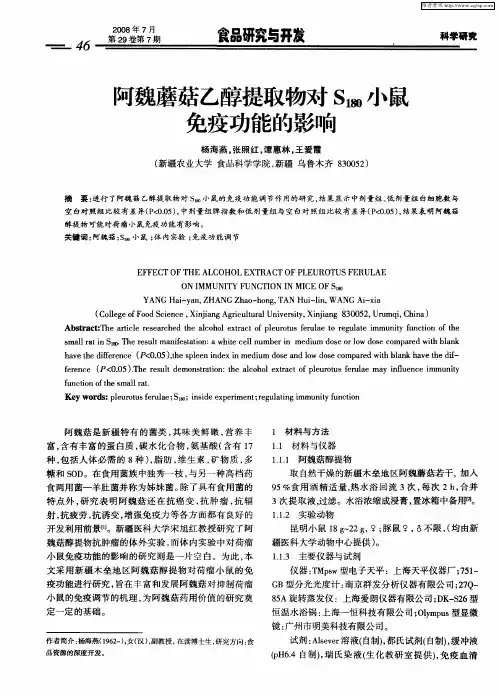
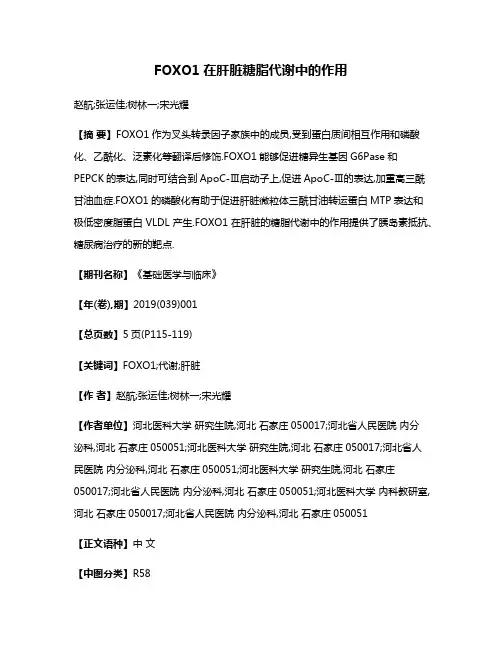
FOXO1在肝脏糖脂代谢中的作用赵航;张运佳;树林一;宋光耀【摘要】FOXO1作为叉头转录因子家族中的成员,受到蛋白质间相互作用和磷酸化、乙酰化、泛素化等翻译后修饰.FOXO1能够促进糖异生基因G6Pase和PEPCK的表达,同时可结合到ApoC-Ⅲ启动子上,促进ApoC-Ⅲ的表达,加重高三酰甘油血症.FOXO1的磷酸化有助于促进肝脏微粒体三酰甘油转运蛋白MTP表达和极低密度脂蛋白VLDL产生.FOXO1在肝脏的糖脂代谢中的作用提供了胰岛素抵抗、糖尿病治疗的新的靶点.【期刊名称】《基础医学与临床》【年(卷),期】2019(039)001【总页数】5页(P115-119)【关键词】FOXO1;代谢;肝脏【作者】赵航;张运佳;树林一;宋光耀【作者单位】河北医科大学研究生院,河北石家庄050017;河北省人民医院内分泌科,河北石家庄050051;河北医科大学研究生院,河北石家庄050017;河北省人民医院内分泌科,河北石家庄050051;河北医科大学研究生院,河北石家庄050017;河北省人民医院内分泌科,河北石家庄050051;河北医科大学内科教研室,河北石家庄050017;河北省人民医院内分泌科,河北石家庄050051【正文语种】中文【中图分类】R58作为人体的解毒器官,肝脏也在机体的代谢稳态中发挥中心作用,它是碳水化合物、脂质和蛋白质合成、代谢、储存、重新分配的主要器官。
肝脏作为胰岛素作用的敏感组织之一,其糖脂代谢的紊乱,会引起肥胖、胰岛素抵抗、糖尿病、非酒精性脂肪肝等多种代谢综合征的发生。
近年来研究发现叉头转录因子(forkhead box transcription factor,FOXO)蛋白在发育、应激反应、凋亡、营养、长寿方面发挥重要作用[1-2]。
作为胰岛素样信号的主要靶点,FOXO在肝脏糖脂代谢上的作用也逐步受到关注,其参与了肝脏的糖异生、脂质合成等过程。
1 FOXO概述“FOX”名字最初源于黑腹果蝇“叉头”基因,它是第一个被发现的叉头盒转录因子。
吉非替尼通过增加 Foxo3a 活性抑制肺纤维化小鼠上皮-间质转分化彭婷;杜海坚;李理;李伟峰;黄文杰【摘要】AIM:To identify the effect of gefitinib on the expression of forkhead box protein O 3a (Foxo3a),α-smooth muscle actin (α-SMA) and related signal pathway molecules in the mice with bleomycin-induced lung fibrosis and to investigate the inhibition mechanism of gefitinib on lung epithelial-mesenchymal transition.METHODS: Thirty Kunming female mice were randomly divided into 3 groups:control group (received normal saline intratracheally ), bleomy-cin group (received bleomycin intratracheally , 3 mg/kg), and bleomycin plus gefitinib group (received bleomycin intratra-cheally and gefitinib orally, 20 mg/kg).All the mice were sacrificed 14 d after the treatments.Pulmonary histological changes were evaluated by hematoxylin-eosin staining and Masson trichrome staining .The mRNA levels of Foxo3a and α-SMA in the lung tissues were detected by RT-PCR.Nuclear Foxo3a, α-SMA, and phosphorylation of EGFR, Akt andFoxo3a in the lung tissues were determined by Westernblotting .RESULTS:Gefitinib inhibited bleomycin-induced lung fi-brosis and significantly decreased the scores of lung inflammation andfibrosis .Foxo3a mRNA expression and total Foxo3a protein expression were increased, while the phosphorylated Foxo3a was decreased.Nuclear Foxo3a was increased signifi-cantly.Meanwhile, phosphorylated EGFR and Akt were decreased .The level of α-SMA was observably increased .CON-CLUSION:Gefitinib restores Foxo3a activity and reduces α-SMA expression by modulating EGFR/Akt activity, thus in-hibiting bleomycin-induced lung fibrosis.%目的:研究吉非替尼对肺纤维化小鼠转录因子叉头框蛋白O3a (Foxo3a)活性、α-平滑肌肌动蛋白(α-SMA)水平及相关通路的影响,探讨吉非替尼抑制肺上皮-间质转分化的可能机制。
泽泻醇在小胶质细胞中对基质金属蛋白酶3与一氧化氮的抑制作用刘瑜【摘要】This paper investigates the inhibitory effect and mechanism of alismol on neuroinflamination in the activated BV2 microglial cells which are stimulated by lipopolysaccharides(LPS). NO was measured by using Griess reagent. RT-PCR and Western blot are used to analyse ERK, JNK, Akt, and MMP3 . Alismol can significantly inhibit LPS-induced NO production and the MMP3 expression. The mechanism is involved to its inhibition of PI3K/Akt pathway.%利用脂多糖(LPS)刺激小鼠小胶质细胞BV2,研究泽泻醇对炎症相关分子的抑制及机制.Griess法测定一氧化氮(NO)浓度,RT-PCR和Western blot法检测细胞外调节蛋白激酶(ERK)、p38、c-Jun氨基末端激酶(JNK)、蛋白激酶B(Akt)、基质金属蛋白酶3(MMP3)的变化.研究结果表明,泽泻醇不仅对LPS刺激小胶质细胞产生的NO有明显抑制作用,还能在mRNA与蛋白质水平抑制MMP3的表达,这种抑制与其对PI3K/Akt通路的干预相关.阐述了泽泻醇对小胶质细胞的抑制与PI3K/Akt通路的相关机制.【期刊名称】《实验技术与管理》【年(卷),期】2012(029)010【总页数】4页(P47-50)【关键词】小胶质细胞;泽泻醇;一氧化氮;基质金属蛋白酶3【作者】刘瑜【作者单位】南开大学医学院,天津 300071【正文语种】中文【中图分类】R914Abstract:This paper investigates the inhibitory effect and mechanism of alismol on neuroinflammation in the activated BV2microglial cells whichare stimulated by lipopolysaccharides(LPS).NO was measured by using Griess reagent.RT-PCR and Western blot are used to analyse ERK,JNK,Akt,and MMP3 .Alismol can significantly inhibit LPS-induced NO production and the MMP3expression.The mechanism is involved to its inhibition of PI3K/Akt pathway.Key words:microglia;alismol;NO;MMP3小胶质细胞是中枢神经系统内的免疫细胞,长期激活而形成中枢神经系统的慢性炎症,其释放的大量氧自由基、炎症介质细胞因子以及基质金属蛋白酶(matrix metalloproteinases,MMP)是神经元损伤的重要原因之一,也是阿尔茨海默病(Alzheimer’s disease,AD)与帕金森病(Parkinson’s disease,PD)等许多中枢神经退行性疾病发生与发展的重要因素之一[1-2]。
罗格列酮和二甲双胍对小鼠脂肪组织转录因子FoxO3a蛋白表达的影响李玉秀;曾静波;孙琦;王妲【期刊名称】《基础医学与临床》【年(卷),期】2008(028)003【摘要】目的观察KKAy小鼠脂肪组织FoxO3a的表达及罗格列酮和二甲双胍处理后该蛋白表达的变化.方法对照组为16周龄C57BL小鼠7只,实验组KKAy糖尿病小鼠组21只,随机分为3组:糖尿病对照组,罗格列酮组,二甲双胍处理组,为期4周.取附睾脂肪垫,用Western blot方法检测FoxO3a的蛋白表达.结果 KKAy糖尿病小鼠脂肪组织FoxO3a表达明显高于对照组,分别为1.76±0.19和1.15:±0.10(P<0.001),罗格列酮组FoxO3a表达为1.43±0.24,显著低于糖尿病组(P<0.05),与对照组相近;二甲双胍组FoxO3a表达为1.57 ±0.23与糖尿病对照无差别.结论罗格列酮改善胰岛素抵抗可能与FoxO通路有关;二甲双胍改善血糖和胰岛素抵抗可能与此无关.【总页数】4页(P260-263)【作者】李玉秀;曾静波;孙琦;王妲【作者单位】中国医学科学院,中国协和医科大学,北京协和医院,内分泌科,卫生部内分泌重点实验室,北京,100730;中国医学科学院,中国协和医科大学,北京协和医院,内分泌科,卫生部内分泌重点实验室,北京,100730;中国医学科学院,中国协和医科大学,北京协和医院,内分泌科,卫生部内分泌重点实验室,北京,100730;中国医学科学院,中国协和医科大学,北京协和医院,内分泌科,卫生部内分泌重点实验室,北京,100730【正文语种】中文【中图分类】R587.1【相关文献】1.罗格列酮和二甲双胍治疗对胰岛素抵抗KKAy糖尿病小鼠肝及横纹肌组织PTEN 蛋白表达的影响 [J], 曾静波;李玉秀;孙琦;王姮2.中链脂肪酸对高脂肪饲料诱导的肥胖C57BL/6J小鼠脂肪组织中转录因子的影响[J], 刘英华;张永;徐庆;于晓明;张新胜;王觐;杨雪艳;薛长勇3.中链脂肪酸对高脂肪饲料诱导的肥胖C57BL/6J小鼠脂肪组织中转录因子的影响[J], 刘英华;张永;徐庆;于晓明;张新胜;王觐;杨雪艳;薛长勇;4.罗格列酮对db/db小鼠脂肪组织锌alpha2糖蛋白及线粒体生物合成相关因子表达的影响 [J], 肖新华;李芬;冉莉;周峻林;李菡;杨靖;刘江华;文格波5.转录因子Foxo3a高表达对小鼠T淋巴瘤EL-4细胞周期和凋亡的影响 [J], 马晓杰;刘光伟;王娜;崔旻;李景鹏;赵勇因版权原因,仅展示原文概要,查看原文内容请购买。
纟宗FOXO3a 的调控机制与功能及其在临床中的应用**天津市自然科学基金资助项目(编号:13JCYBJC21200)△通信作者:主任医师,教授,硕士研究生导师;E - mail : pang-hua2006@ sina. com陈磊',邱丽君',王新超,,庞华仏天津市第四中心医院'检验科,$肿瘤血液科(天津300140)【摘要】FOXO3a 是FOX ( forkhead box)蛋白家族的一个重要成员,通过磷酸化、泛素化降解、乙酰化或去乙酰化及microRNA 方式在抑制肿瘤细胞增殖、细胞周期进程、促进凋亡及氧化应激和延长寿命中发挥重 要作用。
本综述主要对FOXO3a 调控机制与功能及其在临床应用中的最新研究进展进行讨论,为临床诊断和靶向治疗提供新的思路"【关键词】FOXO3a ;调控机制与功能;肿瘤;靶向治疗【中图分类号】R730. 1 ;R730.231【文献标志码】ADOI : 10. 13820/j. cnki. gdyx. 20165037人类叉头框0( forkhead box 0, FOXO )蛋白具 有一个高度保守的110个氨基酸的叉头框或翼螺旋的DNA 结合结构域,该结构域由3个a 螺旋、3个[3 折叠及2个翼状结构组成⑴。
分类上从FOXA 到FOXR 的FOXO 蛋白由超过100个成员组成,其中 FOXO 亚家族4个主要成员分别是FOXOl 、FOXO3a 、 FOXO4和F 0X06。
这些成员都与细胞存活,增殖和DNA 损伤修复相关。
而在FOXO 亚家族当中研究最多的为F0X03a o 具有抑制细胞周期进程,促 进细胞死亡功能的FOXO3a 被认为有可能是抑制癌细胞发展的一个重要靶点。
然而,最近研究发现 FOXO3a 还具有与应激反应和寿命相关的其他功能⑵。
本文对FOXO3a 的调控机制与功能,以及在 临床应用中的研究进展进行综述。
1 FOXO3a 的调控机制1. 1 磷酸化 FOXO3a 通过如磷酸化(phosphoryla tion )A 乙酰化(acetylation )和泛素化(ubiquitination ) 的翻译后修饰,调控FOXO 蛋白转录活性。
FoxO转录因子的活性调节及对哺乳动物细胞进程的调控王远孝;王恬【期刊名称】《生物技术通报》【年(卷),期】2009(000)007【摘要】FoxO transcriptional factors play a critical role in cell differentiation, proliferation, and survival in mammals. The transcriptional activity of FoxOs is regulated by multiple pathways, such as PI3K-dependent way, CBP/p300-mediated acetylation and Sirt1-mediated deacetylation, Ubiquitination and degradation, and other signaling pathways.FoxO that induces the cell proliferation and controls the cell cycle, is a switch between survive and death of cells. FoxO and other cell cycle regulators join as a complex network of cell signals and then control the progress of cell cycle.%FoxO转录因子在哺乳动物的细胞分化、增殖和细胞存活中发挥着重要调控作用,其转录活性受PI3K通路、非PI3K依赖通路、乙酰化和泛素化作用等多种途径调控.FoxO受到上游信号分子PI3K/Akt、SGK等的激活,调节靶基因的转录,从而调节哺乳动物细胞周期的进程和凋亡事件.FoxO已成为肿瘤、癌症科学研究的热点之一.【总页数】4页(P31-34)【作者】王远孝;王恬【作者单位】南京农业大学动物科技学院,南京,210095;南京农业大学动物科技学院,南京,210095【正文语种】中文【中图分类】Q95【相关文献】1.四环素调控表达系统调节EGFP和HBV前核心蛋白在哺乳动物细胞中表达 [J], 朱晓东;姚丰;田波2.肌球蛋白Ⅱ马达活性与肌动蛋白纤维共同调节哺乳动物细胞胞质分裂 [J], 杨芳;安美文;李晓娜;王立3.FoxO转录因子的活性调控及其对骨骼肌生长发育的调节 [J], 朱宇旌;于治姣;张勇;李艳;邵彩梅4.FOXO3和转录因子SOHLH1对卵母细胞特异性表达基因Bmp15转录活性的调控 [J], 刘源;杜冰;张雪;金美玉;郑志红5.FOXO转录因子调控哺乳动物的细胞周期和凋亡 [J], 周振琪;王恬;石放雄因版权原因,仅展示原文概要,查看原文内容请购买。
CELL INJURY,REPAIR,AGING,AND APOPTOSISCritical Role of FoxO3a in Alcohol-Induced Autophagy and HepatotoxicityHong-Min Ni,*Kuo Du,*Min You,y and Wen-Xing Ding*From the Department of Pharmacology,Toxicology,and Therapeutics,*University of Kansas Medical Center,Kansas City,Kansas;and the Department of Molecular Pharmacology and Physiology,y University of South Florida Health Sciences Center,Tampa,FloridaAccepted for publication August19,2013.Address correspondence to Wen-Xing Ding,Ph.D., Department of Pharmacology, Toxicology,and Therapeutics, University of Kansas Medical Center,MS1018,3901 Rainbow Blvd.,Kansas City, KS66160.E-mail:wxding@ .Autophagy is a lysosomal degradation process that degrades long-lived cellular proteins and damaged organelles as a critical cell survival mechanism in response to stress.We recently reported that acute ethanol induces autophagy,which then reduces ethanol-induced liver injury.However,the mechanisms by which ethanol induces autophagy are not known.In the present study,ethanol treatment significantly increased both mRNA and protein levels of various essential autophagy-related genes in primary cultured mouse hepatocytes and in mouse liver.Both nuclear translocation of FoxO3a and expression of FoxO3a target genes were increased in ethanol-treated primary hepatocytes and mouse liver.Overexpression of a dominant negative form of FoxO3a inhibited ethanol-induced autophagy-related gene expression and enhanced ethanol-induced cell death in primary hepatocytes,which suggests that FoxO3a is a key factor in regulating ethanol-induced autophagy and cell survival.Resveratrol,a well-known SIRT1agonist, further enhanced ethanol-induced expression of autophagy-related genes,likely via increased deacety-lation of FoxO3a.Moreover,acute ethanol e treated Foxo3aÀ/Àmice exhibited decreased autophagy-related gene expression,but enhanced steatosis and liver injury,compared with wild-type mice. FoxO3a thus plays a critical role in ethanol-induced autophagy in mouse liver.Modulating the FoxO3a autophagy pathway may offer novel therapeutic approaches for treating alcoholic liver pathogenesis. (Am J Pathol2013,183:1815e1825;/10.1016/j.ajpath.2013.08.011)Macroautophagy(hereafter referred to simply as autophagy) is a bulk intracellular degradation system that is mainly responsible for the degradation of long-lived proteins to provide nutrients for survival in response to starvation.1,2 Accumulating evidence indicates that autophagy can also selectively remove damaged or excess organelles,including mitochondria,endoplasmic reticulum,ribosome,and per-oxisome.3e5In the liver,autophagy can also help to remove excess lipid droplets to attenuate steatosis(in which case it is termed lipophagy).6Alcoholic liver disease is a major disease of the liver in Western countries and worldwide.The clinical characteristic of this disease is the accumulation of excess fat in the liver in response to alcohol consumption.In humans,it is known that accumulation of excess fat can progress to more detrimental forms of liver injury,such as inflammation,fibrosis,and cirrhosis.However,it is also well known that only a small portion of alcohol drinkers can develop advanced liver inflammation andfibrosis,suggesting that a cellular protective mechanism or mechanisms could play a critical role in miti-gating alcohol-induced liver injury.7,8Our research group recently demonstrated that acute ethanol treatment induces autophagy in primary cultured mouse hepatocytes and in mouse liver;pharmacological induction of autophagy attenu-ated and pharmacological inhibition of autophagy exacerbated ethanol-induced steatosis and liver injury in mice.9However, the mechanisms by which acute ethanol induces autophagy in hepatocytes are not known.FoxO3a is a member of the FoxO(forkhead box O) family of transcription factors.FoxO3a regulates expression of genes involved in multiple cellular functions,including oxidative stress,apoptosis,and cell-cycle transition,as well as DNA repair.10,11Recent evidence suggests that FoxO3a Supported in part by NIH grants R01-AA020518-01and P20-RR021940 (W.X.D),R01-AA015951and R01-AA013623(M.Y.),and P20-GM103549(COBRE grant to the University of Kansas Medical Center Cell Isolation Core laboratory).Copyrightª2013American Society for Investigative Pathology. Published by Elsevier Inc.All rights reserved./10.1016/The American Journal of Pathology,Vol.183,No.6,December2013also regulates expression of autophagy-related(Atg)genes in mouse skeletal muscle12,13and cardiomyocytes,which promotes cardiomyocyte survival on induction of oxidative stress.14FoxO3a is regulated by multiple post-translational modi-fications,including phosphorylation,acetylation,and ubiq-uitination.10,11FoxO3a is phosphorylated by the serine/ threonine protein kinase Akt and becomes sequestered in the cytoplasm,where it is unable to regulate gene expression.In contrast,SIRT1[sirtuin(silent mating type information regulation2homolog)1(S.cerevisiae)]deacetylates FoxO3a and modulates its gene transcription and specificity,which increases antioxidative stress genes and suppresses apoptosis genes in response to oxidative stress.10,15However,it is not known whether acetylation of FoxO3a affects expression of autophagy-related genes.In the present study,we demonstrated that acute ethanol treatment activates FoxO3a in mouse liver and in primary cultured mouse hepatocytes.The increased nuclear retention of FoxO3a by ethanol could be mediated by decreased Akt activity.Genetic inhibition of FoxO3a led to the suppression of ethanol-induced expression of autophagy-related genes and exacerbated ethanol-induced liver injury in mice.Moreover, we also found increased autophagy-related gene expression and autophagicflux in ethanol-treated human hepatocytes.Materials and MethodsReagentsThe following antibodies were used:Atg5(PM050)from MBL International(Woburn,MA);Beclin1(sc11427)and ULK1 (sc33182)from Santa Cruz Biotechnology(Santa Cruz,CA); Bnip3(Ab10433)and Nix(Ab8399)from Abcam(Cambridge, MA);p62(H00008878-M01)from Abnova(Walnut,CA); Atg7(2631),p-FoxO3a S253(9466),FoxO3a(2497),p-Akt S473 (4060),Akt(2966),Sirt1(2028),anti e acetylated-lysine (9441),and Lamin A/C(2032)from Cell Signaling Technol-ogy(Danvers,MA);and b-actin(A5441)and Atg14(A6358) from Sigma-Aldrich(St.Louis,MO).Horseradish perox-idase e conjugated or Cy3-conjugated secondary antibodies were from Jackson ImmunoResearch Laboratories(West Grove,PA).Rabbit polyclonal anti-LC3B antibody was generated as described previously.9Adenovirus GFP-LC3 (Ad-GFP-LC3),Ad-GFP,and adenovirus-dominant negative FoxO3a(Ad-DN-Foxo3a)were generated as described previ-ously.12,16Chloroquine(CQ),rapamycin,actinomycin D (ActD),and resveratrol were from Sigma-Aldrich.Ethanol was from Pharmco(Brookfield,CT),and all other chemicals were from Sigma-Aldrich,Life Technologies(Carlsbad,CA),or Calbiochem(EMD Millipore,Billerica,MA).AnimalsWild-type C57BL/6mice were purchased from the Jackson Laboratory(Bar Harbor,ME).Foxo3aÀ/Àmice were generated as described previously.17Cryopreserved Foxo3aþ/Àmouse embryos were purchased from the RIKEN BioResource Center (Ibaraki,Japan)and recovered at the Animal Transgenic Core facility at the University of Kansas Medical Center.The Foxo3aþ/Àmice were maintained in a B6;129background. Female Foxo3aÀ/Àmice are infertile;Foxo3aÀ/Àmice were therefore generated by crossing male Foxo3aþ/Àwith female Foxo3aþ/Àmice.The generated Foxo3aþ/þmice were used as wild-type controls.All animals received humane care according to the guidelines of the NIH and the University of Kansas Medical Center.Mouse Ethanol Binge TreatmentMouse ethanol treatment was modified from the model of Carson and Pruett,18as we have described previously.9This model was designed to achieve blood alcohol levels,behavioral effects,and physiological effects comparable to those of human binge drinking.After6hours of fasting,male Foxo3aÀ/Àmice and their wild-type littermates were administered33%(v/v) ethanol at a total cumulative dose of4.5g/kg body weight by four equally divided gavages at15-minute intervals.Control mice received the same volume of double-distilled water.After 6,12,and16hours of treatment,the mice were sacrificed,and blood samples and liver tissues were collected.Liver injury was assessed by determination of serum alanine aminotransferase activity and H&E staining of liver sections,as we have de-scribed previously.19Total liver lysates were prepared using radioimmunoprecipitation assay buffer[1%NP40,0.5%so-dium deoxycholate,0.1%sodium dodecyl(lauryl)sulfate]. Primary Hepatocyte CultureMouse hepatocytes were isolated by a retrograde,nonre-circulating perfusion of livers with0.05%collagenase type IV (Sigma-Aldrich),as we have described previously.20Cells were cultured in Williams’medium E with10%fetal bovine serum,but no other supplements,for2hours to allow for attachment.Human hepatocytes were isolated and cultured according to methods described previously by Gramignoli et al.20All cells were maintained in a37 C incubator with5% CO2.All human liver specimens were obtained in accordance with the protocol(no.13513)approved by the University of Kansas Medical Center Human Subjects Committee. Immunoblot AssayCells were washed in PBS and lysed in radioimmunopre-cipitation assay buffer.From each sample,20m g of protein was separated by SDS-PAGE and transferred to polyvinylidene difluoride membranes.The membranes were immunoblotted with primary antibodies,followed by secondary horseradish peroxidase-conjugated antibodies.The membranes were further developed with Pierce SuperSignal West Pico chemi-luminescent substrate(Thermo Fisher Scientific,Rockford,Ni et al-The American Journal of PathologyIL).Densitometry analysis was performed using Un-Scan-It software version6.1(Silk Scientific,Orem,UT).Densitometry data were further normalized with either b-actin or the respective total protein and expressed as meansÆSEM. qPCRRNA was isolated from mouse livers using TRIzol reagent(Life Technologies)and was reverse-transcribed into cDNA with Fermentas RevertAid Reverse Transcriptase(Thermo Fisher Scientific,Waltham,MA).Quantitative real-time PCR(qPCR) to quantify gene expression of Atg5,Beclin1(Becn1;alias Atg6),Atg7,microtubule-associated protein1light chain3 beta(Map1lc3b;alias LC3b),Ulk1,BCL2/adenovirus E1B interacting protein3(Bnip3),and b-actin(Actb)was per-formed on an ABI Prism7900HT real-time PCR instrument (Life Technologies)using Fermentas Maxima SYBR Green/ ROX qPCR reagents(Thermo Fisher Scientific).The forward and reverse primer sequences were as follows:b-actin,50-TGTTACCAACTGGGACGACA-30and50-GGGGTGTT-GAAGGTCTCAAA-30;Atg5,50-GACCACAAGCAGCT-CTGGAT-30and50-GGTTTCCAGCATTGGCTCTA-30; Beclin1(Atg6),50-TGATCCAGGAGCTGGAAGAT-30and 50-CAAGCGACCCAGTCTGAAAT-30;Atg7,50-TCCGT-TGAAGTCCTCTGCTT-30and50-CCACTGAGGTTCAC-CATCCT-30;LC3B,50-CCGAGAAGACCTTCAAGCAG-30and50-ACACTTCGGAGATGGGAGTG-30;ULK1,50-GGTGGAGACCTGGCTGACTA-30and50-TCTTGACTC-GGATGTTGCTG-30;and Bnip3,50-AGCTTTGGCGAGA-AAAACAG-30and50-TCCAATGTAGATCCCCAAGC-30. Microscopy for Autophagy and Cell DeathTo examine autophagy,primary mouse hepatocytes were seeded in a12-well plate(2Â105cells per well)and infected overnight with Ad-GFP-LC3(100viral particles per cell).Cells were treated with80mmol/L ethanol in the presence or absence of0.1m g/mL ActD or with50m mol/L resveratrol for6hours. After treatment,cells werefixed with4%paraformaldehyde in PBS for2hours at room temperature or were kept at4 C for microscopy.Fluorescence images were acquired under an Eclipse200fluorescence microscope(Nikon,Tokyo,Japan) with MetaMorph software version6.1(Downingtown,PA). For the immunostaining assay,fixed primary hepatocytes or cryosections of liver tissues were immunostained with anti-FoxO3a antibody followed by Cy3-conjugated secondary antibody and Hoechst33342nuclear staining,as described previously.21Cell death and morphological changes were analyzed with1m g/mL Hoechst33342staining andfluores-cence imaging.All images were obtained using digitalfluo-rescence microscopy as described above.Nuclear FractionationMouse liver nuclear proteins were extracted using Pierce NE-PER nuclear and cytoplasmic extraction reagents (Thermo Fisher Scientific)according to the manufacturer’s instructions.In brief,liver tissues were cut into small pieces, homogenized in cytoplasmic extraction reagent I with sub-sequent addition of cytoplasmic extraction reagent II,and centrifuged.The supernatants resulting from centrifugation were cytoplasmic fractions.The insoluble pellets were suspended in nuclear extraction reagent and centrifuged;the supernatants resulting from this centrifugation contained nuclear proteins.Hepatic Triglyceride AnalysisTriglyceride level was determined as described previously.9 Frozen liver tissues(50to100mg)were ground using a mortar and pestle.The crushed liver tissues were further incubated with1mL of a chloroform/methanol(2:1)mix with vigorous shaking for1hour at room temperature.Then, 200m L of double-distilled water was added into the mix and centrifuged for5minutes at3000Âg.The lower lipid phase was collected and dried at room temperature,and the pellet was redissolved in a tert-butanol and Triton X-114/meth-anol(2:1)mix.Triglyceride analysis was performed with a colorimetric assay kit according to the manufacturer’s in-structions(Sigma-Aldrich).Statistical AnalysisExperimental data were subjected to a Student’s t-test or one-way analysis of variance analysis with Scheffé’s post hoc test where appropriate.P<0.05was considered significant. ResultsAcute Ethanol Treatment Increases the Expression of Autophagy Genes in Mouse Liver and in Primary Cultured Mouse HepatocytesTo investigate the expression of autophagy-related genes in mouse liver,male wild-type C57BL/6mice were adminis-tered4.5g/kg of water or ethanol for6,12,and16hours.This animal model,initially established by Carson and Pruett,18 has been widely used to mimic human binge drinking and acute alcohol abuse.22,23In this model,an ethanol dose of4to 6g/kg via gavage resulted in a peak blood ethanol concen-tration of43.4to86.8mmol/L,which can be commonly achieved in human binge drinkers.22Using this acute alcohol gavage model,we found that the mRNA levels of various autophagy-related genes,including Ulk1(yeast Atg1),Atg5, Becn1(yeast Atg6),Atg7,LC3b(yeast Atg8),Atg14,and Pik3c3(alias Vps34)were all increased in ethanol-treated mouse liver at all time points.Expression levels of most genes that we assessed(Ulk1,Becn1,LC3b,Atg14,and Vps34)peaked after6hours of treatment with ethanol (Figure1A).Expression levels of these autophagy-related genes started to decrease after12and16hours of treatment with ethanol,but were still significantly higher than inFoxO3a in Alcohol-Induced AutophagyThe American Journal of 1817controls (Figure 1A).Consistent with increased mRNA expression,ethanol treatment also increased Atg5,Beclin 1,Atg7,and LC3B-II protein levels;however,the extent of increase and the respective peak time varied.The expression levels of some proteins (such as Atg5)increased approxi-mately threefold,whereas expression levels of others (such as Atg7and Beclin 1)increased 60%to 80%,compared with control (Figure 1,B and C).It seems that Atg5,Beclin 1,and Atg14were maintained at higher levels during the treatment,whereas Atg7and LC3B-II increased at 6hours but then slightly declined at 12and 16hours of ethanol treatment.We have previously demonstrated an increase in autophagic flux induced by ethanol;in the presence of CQ,which blocks lysosomal degradation,ethanol-induced LC3B-II levels were further enhanced by CQ treatment.9Therefore,the decreased LC3B-II levels after prolonged ethanol treatment (12and 16hours)were likely due to autophagic degradation of LC3B-II.Consistent with in vivo findings,we also found elevated mRNA levels of several autophagy-related genes in ethanol-treated primary mouse hepatocytes as early as 3hours and sustained to 16hours (Figure 1C).Moreover,ethanol treat-ment also increased Atg5,Beclin 1,Atg7,and LC3B-II protein levels in a time-dependent manner (Figure 1D).ActD Suppresses Ethanol-Induced Expression of Autophagy-Related Proteins and GFP-LC3PunctaTo further investigate the role of gene transcription in ethanol-induced autophagy,we treated primary cultured mouse hepatocytes with ethanol in the presence or absence of ActD,a general transcription inhibitor.Beclin 1,Atg7,Bnip3,and LC3B-II protein levels induced by ethanol decreased in the presence of ActD (Figure 2A).Consistentwith our previous reports,9ethanol treatment increased the number of GFP-LC3puncta in primary cultured mouse hepatocytes,and these puncta were signi ficantly diminished by ActD (Figure 2,B and C).More importantly,ActD also blocked ethanol-induced autophagic flux,as demonstrated by the decreased LC3B-II levels when cells were treated with ethanol together with ActD and CQ,compared with the cells treated with ethanol and CQ.Furthermore,ethanol treatment also decreased levels of p62,an autophagic sub-strate protein that is usually degraded by autophagy.Ethanol-induced decrease of p62was blocked by ActD,indicating that ActD inhibited ethanol-induced autophagic flux in hepatocytes (Figure 2D).These results suggest that ethanol-induced expression of autophagy-related genes could play an important role in ethanol-induced autopha-gosome formation and autophagic flux.Ethanol Activates FoxO3a Both in Vivo and in VitroDuring mouse muscle atrophy,FoxO3a is activated to pro-mote autophagy by up-regulating autophagy-related genes,including LC3b ,Atg12,and Becn1.12In the present study,ethanol treatment increased Beclin 1,Atg7,Bnip3,and LC3B protein levels,and expression of these proteins was sup-pressed by ActD.We therefore investigated whether ethanol also activates FoxO3a and in turn increases the transcription of Atg genes in hepatocytes.FoxO3a signals were diffuse in both cytosol and nucleus in the liver of control mice,but the FoxO3a nuclear signal dramatically increased after ethanol treatment,indicating that ethanol increased nuclear FoxO3a retention in mouse liver (Figure 3A).Western blot analysis using nuclear fractions showed that ethanol treatment increased nuclear FoxO3a levels approximatelytwofoldFigure 1Acute ethanol treatment increases the expression of autophagy-related genes in mouse liver and primary hepatocytes.A :Male C57BL/6mice were treated with 4.5g/kg water or ethanol by gavage for 6,12,or 16hours.Hepatic mRNA was isolated,and RT-qPCR was performed.B :Mice were treated as for A ,and total liver ly-sates were subjected to Western blot analysis,followed by densitometry analysis.C :Primary cultured mouse hepatocytes were treated with 80mmol/L ethanol for 3,6,9,and 16hours.mRNA was isolated from cultured hepatocytes,and RT-qPCR was performed.D :Primary cultured mouse hepatocytes were treated as for C ,and total cell lysates were subjected to Western blot anal-ysis,followed by densitometry analysis.Data are presented as means ÆSEM (fold of control).n Z 4e 6(A );n Z 4(B and C );n Z 3(D ).*P <0.05,one-way analysis of variance with Scheffé’s post hoc test.Ni et al-The American Journal of Pathology(Figure 3B).Moreover,hepatic mRNA levels of three known FoxO3a target genes [Bnip3,Bim (reclassi fied as Bcl2l11),and manganese superoxide dismutase (Sod2;alias MnSOD )]also increased in ethanol-treated mouse liver (Figure 3C).Similar to the in vivo findings,ethanol treatment also sig-ni ficantly increased nuclear FoxO3a levels in primary cultured mouse hepatocytes (Figure 3,D and E).In addition,ethanol treatment also increased the expression of the known FoxO3a target genes Bnip3,Bnip3L ,and MnSOD in vitro (Figure 3F).These findings indicate that ethanol activates FoxO3a in mouse liver and in primary cultured mouse hepatocytes.Ethanol Induces Alterations of the Post-Translational Modi fications of FoxO3a in Mouse LiverBecause FoxO3a is regulated by multiple post-translational modi fications,including phosphorylation and acetylation,10we next investigated whether ethanol treatment affects phosphorylation and acetylation of pared with control mice,ethanol treatment decreased the level of p-FoxO3a in mouse liver (Figure 4A).These findings are consistent with our immunostaining data and nuclear Western blot analysis,showing that ethanol increased nu-clear FoxO3a (Figure 3A),because p-FoxO3a is liable to be exported to the cytosol from the nucleus.This decreased phosphorylation of FoxO3a could be due to decreased Akt phosphorylation,because Akt phosphorylates FoxOs to promote their nuclear exportation.11Indeed,the p-Akt levels in ethanol-treated mouse livers were decreased,compared with control (Figure 4A).In addition to phosphorylation,the transcriptional activity of FoxO3a can also be regulated bySirt1-mediated deacetylation.Ethanol treatment decreased hepatic Sirt1(Figure 4B),which was correlated with increased acetylated FoxO3a (Figure 4C).These data indi-cate that acute ethanol treatment decreases the level of phosphorylated FoxO3a,but increases acetylated FoxO3a;the latter is likely associated with a decrease in hepatic Sirt1induced by ethanol treatment.Resveratrol Further Increases Ethanol-Induced Autophagy Gene Expression by Decreasing FoxO3a AcetylationTo investigate the in fluence of acetylation of FoxO3a on ethanol-induced expression of autophagy-related genes,we treated primary mouse hepatocytes with ethanol in the presence or absence of resveratrol,a well-known Sirt1agonist 24that decreases ethanol-induced liver injury.25We found that resveratrol alone slightly increased the mRNA levels of Atg5,LC3b ,and Vps34,but the combined treat-ment of ethanol and resveratrol further increased ethanol-induced expression of these autophagy-related genes (Figure 5A).Ethanol-induced acetylation of FoxO3a was suppressed by resveratrol (Figure 5B),suggesting that deacetylated FoxO3a may further promote autophagy-related gene transcription.More importantly,in the pres-ence of resveratrol,the number of ethanol-induced GFP-LC3puncta was further increased,suggesting that resveratrol enhances ethanol-induced autophagosome formation (Figure 5,C and D).These findings indicate that Sirt1-mediated deacetylation of FoxO3a may promote expres-sion of autophagy-related genes and autophagy induction in ethanol-treatedhepatocytes.Figure 2ActD inhibits ethanol-induced auto-phagy in primary mouse hepatocytes.A :Primary cultured hepatocytes were treated with ethanol in the presence or absence of ActD for 6hours.Total cell lysates were subjected to Western blot anal-ysis,followed by densitometry analysis.B :Ad-GFP-LC3e infected hepatocytes were treated as for A and were examined with fluorescence microscopy.Original magni fication,Â60.C :GFP-LC3puncta were quanti fied for each experiment,with at least 30cells counted in each experiment.D :Primary hepatocytes were treated as for A ,with or without 20m mol/L CQ for 6hours,followed by Western blotting and densitometry analysis.Data are expressed as means ÆSEM.n Z 3(A and D );n Z 4(C ).**P <0.01,one-way analysis of variance with Scheffé’s post hoc test.FoxO3a in Alcohol-Induced AutophagyThe American Journal of Pathology- 1819Overexpression of a DN-FoxO3a Suppresses Ethanol-Induced Expression of Autophagy-Related Genes and Enhances Ethanol-Induced Apoptosis in HepatocytesTo determine whether overexpression of DN-FoxO3a sup-presses ethanol-induced expression of autophagy-relatedgenes,we infected primary mouse hepatocytes with Ad-GFP control and Ad-DN-FoxO3a,which also contains GFP from a separate cytomegalovirus promoter.12More than 80%of cells showed very high ef ficiency for the infection after 24hours of incubation (Figure 6A).After the cells were further treated with ethanol for another 6hours,ethanol-induced expression of Becn1,Atg7,LC3b ,and Atg12was inhibited by expression of DN-FoxO3a (Figure 6B).Consistent with the changes at the mRNA level,the ethanol-induced increases in Atg5(Atg12)and Atg6(Beclin 1)protein levels were also inhibited by DN-FoxO3a (Figure 6C).These results suggest that FoxO3a is respon-sible for ethanol-induced expression of autophagy-related genes.Furthermore,overexpression of DN-FoxO3a inhibited ethanol-induced autophagic flux in primary he-patocytes (Figure 6D).Interestingly,we also found that CQ treatment alone only mildly increased LC3B-II levels in DN-FoxO3a e infected cells (1.6versus 1),suggesting that DN-FoxO3a could also inhibit basal autophagy in hepato-cytes (Figure 6D).We previously found that inhibition of autophagy led to increased cell death and liver injury in ethanol-treated primary hepatocytes and mice.9Figure 3Ethanol activates FoxO3a in mouse liver and primary mouse hepatocytes.A :Male C57BL/6mice were treated with 4.5g/kg water or ethanol by gavage for16hours.Cryosectioned liver tissue was subjected to immunostaining for FoxO3a using a rabbit anti-FoxO3a antibody,followed by a Cy3-conjugated goat anti-rabbit antibody;nuclei were stained with Hoechst 33342.Representative fluorescence microscopy images are shown.Boxed regions are shown at higher magni fication at the right .B :Mice were treated as for A ,and nuclear fractions were isolated from control and ethanol-treated mouse liver,followed by Western blotting and densitometry analysis.C :Hepatic mRNA was isolated,and RT-qPCR was performed.D :Primary cultured hepatocytes were treated with 80mmol/L ethanol for 6hours and fixed in 4%paraformaldehyde,then immunostained for FoxO3a as for A ,and examined with fluorescence microscopy.Representative images are shown.E :Cells with increased nuclear FoxO3a staining were quanti fied for each experiment,with at least 100cells counted in each experiment.F :mRNAs were isolated from cultured hepatocytes,and RT-qPCR was performed.Data are presented as means ÆSEM.n Z 3(A ,B ,D ,E ,and F );n Z 4e 6(C ).*P <0.05,Student ’s t -test;**P <0.01,Z -test.GAPDH FoxO3a p-FoxO3aControlEtOHp-Akt S473AktSirt1β-ActinControl EtOHAcetyl-FoxO3aFoxO3aControlEtOH1±0.4 0.6±0.31±0.2 0.5±0.21±0.5 13.2±0.51±0.2 0.4±0.1Figure 4Ethanol induces post-translational modi fication of FoxO3a in mouse liver.A and B :C57BL/6mice were treated with 4.5g/kg water or ethanol by gavage for 16hours.Total liver lysates were subjected to Western blot analysis for phosphorylated and total FoxO3a and phosphorylated and total Akt (A )and Sirt1(B ),followed by densitometry analysis.C :Mice were treated as for A ,and total liver lysates were immunoprecipitated with an anti-FoxO3a anti-body,followed by Western blotting using an anti e acetylated lysine antibody and densitometry analysis.Data are expressed as means ÆSEM.n Z 4.Ni et al-The American Journal of PathologyInterestingly,overexpression of DN-FoxO3a also enhanced ethanol-induced apoptosis in primary mouse hepatocytes (Figure 6E).Therefore,the increased cell death caused by expression of DN-FoxO3a could be due to the inhibition ofethanol-induced expression of autophagy-related genes and subsequent autophagy.Ethanol-Induced Expression of Autophagy-Related Genes Is Suppressed in Foxo3a À/ÀMice,Resulting in Increased Liver Injury and SteatosisTo further investigate the role of FoxO3a in ethanol-induced expression of autophagy-related genes and liver injury in vivo ,we treated Foxo3a À/Àand age-matched wild-type mice with acute ethanol.Although the basal expression of autophagy genes in Foxo3a À/Àmice did not differ sig-ni ficantly from that of wild-type mice,ethanol-induced expression of autophagy-related genes was signi ficantly suppressed in Foxo3a À/Àmice (Figure 7A).The expression levels of several autophagy genes in ethanol-treated FoxO3a wild-type mice (B6;129background),such as Becn1and Atg7,were not induced as signi ficantly as in ethanol-treated C57BL/6J wild-type mice (Figure 1A).These variations could be due to the difference in genetic background.Similar to findings at the mRNA level,several of the ethanol-induced autophagy proteins were also suppressed in Foxo3a À/Àmice (Figure 7D).More importantly,we further found that serum alanine aminotransferase and hepatic tri-glyceride levels were all signi ficantly increased in ethanol-treated Foxo3a À/Àmice,compared with wild-type mice (Figure 7,B and C).Notably,electron microscopy studies revealed that the number of lipid droplets in ethanol-treated Foxo3a À/Àmouse liver was signi ficantly higher than that of wild-type mice,whereas the number of autophagosomes was signi ficantly decreased in ethanol-treated Foxo3a À/ÀFigure 5Resveratrol enhances ethanol-induced expression of autophagy-related genes.A :Primary cultured mouse hepatocytes were treated with ethanol in the presence or absence of 50m mol/L resveratrol (Res)for 6hours.mRNA was isolated from cultured hepatocytes before RT-qPCR was performed.B :Total cell lysates were immunoprecipitated with an anti-FoxO3a antibody,followed by Western blotting using an anti e acetylated lysine antibody and densitometry analysis.C :Ad-GFP-LC3e infected hepatocytes were treated as for A and then were examined with fluorescence microscopy.Representative GFP-LC3images are shown.Original magni fication,Â60.D :The number of GFP-LC3puncta per cell was quanti fied and twenty cells were counted in each experi-ment.Data are expressed as means ÆSEM.n Z 3(A and B );n Z 4(C and D ).*P <0.05,one-way analysis of variance with Scheffé’s post hoctest.Figure 6Overexpression of DN-FoxO3a suppresses ethanol-induced expression of autophagy-related genes,but enhances ethanol-induced apoptosis.A :Representative fluorescence images of primary cultured mouse hepatocytes,infected with 10multiplicity of infection (MOI)Ad-GFP or Ad-DN-FoxO3a,which contain a GFP using separate cytomegalovirus promoters for 24hours.Original magni fication,Â20.B :Primary hepatocytes,infected as in A ,were treated with 80mmol/L ethanol for 6hours.mRNA was isolated from cultured hepatocytes,and RT-qPCR was performed.C :Total cell lysates were subjected to Western blotting and densitometry analysis.D :Primary hepatocytes were treated as in B ,with or without 20m mol/L CQ,for 6hours.Total lysates were subjected to Western blotting and densitometry analysis.E :Primary hepatocytes,infected as in A ,were treated with 80mmol/L ethanol for 24hours.Cells were then stained with Hoechst 33342for nuclei,and fragmented apoptotic nuclei were quanti fied.Data are expressed as means ÆSEM.n Z 3.*P <0.05,one-way analysis of variance with Scheffé’s post hoc test.FoxO3a in Alcohol-Induced AutophagyThe American Journal of Pathology- 1821。